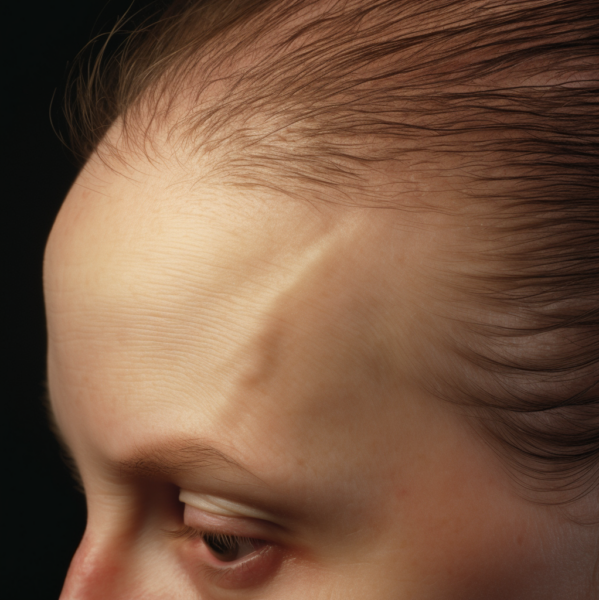Diabetes, a complex metabolic disorder, has far-reaching effects on various body systems, including the skin and hair. Emerging research suggests a bidirectional relationship between diabetes and hair health, where diabetes can contribute to hair loss, and changes in hair characteristics might signal underlying diabetic conditions. This article reviews the potential mechanisms by which diabetes might promote hair loss and reflect the diabetic status of an individual, integrating insights from various studies in the field.
Introduction: Diabetes mellitus, particularly Type 2 Diabetes (DM2), is a global health concern characterized by hyperglycemia and associated metabolic disturbances. While its impact on cardiovascular health, kidney function, and neural pathways is well-documented, the relationship between diabetes and hair health is an area of growing interest. Hair loss or altered hair growth can be both a complication of diabetes and a potential early indicator of metabolic syndrome or prediabetic states.
Mechanistic Insights into the Diabetes-Hair Loss Connection: While the mechanism that underlies hair loss associated with diabetes has not been proven, there are several possible communication and signaling systems that have been suggested could be relevant:
Impaired Blood Circulation: One of the primary mechanisms linking diabetes to hair loss is likely the impairment of blood circulation. Diabetes often leads to microvascular and macrovascular complications, hindering blood flow to extremities, including the scalp. Hair follicles, highly dependent on adequate blood supply for nourishment, suffer in this compromised environment, leading to weakened hair growth or hair loss.Hormonal Imbalances: Diabetes is intricately linked with hormonal imbalances, including insulin resistance and its cascading effects on other hormones. Such imbalances can disrupt the hair growth cycle, leading to conditions like androgenic alopecia (AGA). Studies have shown a correlation between early-onset AGA and metabolic syndrome, a cluster of conditions including increased blood pressure, high blood sugar, excess body fat around the waist, and abnormal cholesterol levels, which often accompany diabetes.Immune System Dysfunction: Diabetes, particularly when poorly managed, can weaken the immune system. This predisposition increases the susceptibility to skin infections and conditions like scalp fungal infections. Indirectly, this could negatively impact hair health and growth in people with diabetes.Stress and Psychological Impact: The chronic nature of diabetes management can induce significant stress, a known trigger for hair loss conditions such as telogen effluvium. Moreover, the psychological impact of dealing with a chronic illness can exacerbate stress-related hair loss. While this link between diabetes and hair loss is indirect, it should not be ignored.Nutritional Deficiencies: Diabetes can affect nutritional absorption and lead to deficiencies in biotin, zinc, magnesium and other essential nutrients vital for hair health. These deficiencies can manifest as weakened hair growth or diffuse hair thinning.Diabetic Medications: Some medications used for diabetes management have side effects that include hair thinning or hair loss. Thus, it is also important to consider the pharmacological aspect of diabetes management in relation to hair health.Hair as a Marker of Diabetic Status: Intriguingly, changes in hair characteristics might also serve as early markers for diabetes or prediabetic states. For instance, studies have shown alterations in scalp hair morphology in diabetic children, including changes in hair bulb and shaft diameters. These changes were indicative of nutritional deficits, potentially linked to their diabetes.
Another dimension of this relationship is evident in studies exploring the association between metabolic syndrome (MetS) and hair loss patterns, particularly in women. Female pattern hair loss (FPHL) has been significantly associated with MetS, suggesting that hair loss in women could be an early indicator of underlying metabolic disturbances common in diabetes.
Moreover, the association of AGA with insulin resistance and cardiovascular risk factors in both men and women further underscores the potential of hair characteristics as non-invasive markers for early detection of metabolic syndrome and diabetes. Early onset AGA, in particular, has been proposed as a marker for metabolic syndrome and carotid artery atherosclerosis.
One medical journal publication suggests hair loss may not just be limited to the scalp, but hair loss might also occur on the lower legs and this could be used as a sign of diabetic status in a person. Such a phenomena could be related to the poor blood circulation in the extremities associated with diabetes.
Implications for Clinical Practice: The interplay between diabetes and hair health has significant implications for clinical practice. Recognizing hair loss as a potential early sign of metabolic disturbances or diabetes could lead to earlier intervention and management, potentially mitigating the progression of these conditions. It also underscores the importance of a holistic approach to diabetes management, considering the patient’s overall dermatological health.
Future Research: Future research should focus on elucidating the molecular pathways connecting diabetes with hair follicle health. Investigating the role of specific hormones, growth factors, and cytokines in this relationship could unveil novel therapeutic targets. Additionally, large-scale epidemiological studies are needed to firmly establish hair characteristics as reliable markers for early diabetes or metabolic syndrome.
Conclusion: The relationship between diabetes and hair loss is multifaceted, involving impaired blood circulation, hormonal imbalances, immune dysfunction, stress, nutritional deficiencies, and medication side effects. Recognizing these connections is crucial for comprehensive diabetes management and leveraging hair characteristics as potential early markers of diabetic conditions. As research progresses, a deeper understanding of these mechanisms will pave the way for more effective interventions and holistic care strategies in diabetes management.
Bibliography
11711645 {11711645:J7W9W5GU},{11711645:NGBD386F},{11711645:AX4GNG4Z},{11711645:CU94DP57},{11711645:ZJ9ZAWSH},{11711645:JJQ8W43W},{11711645:APRXU6JE},{11711645:NAM6TVJ2},{11711645:RURWKCVH},{11711645:9VUZCQ2I},{11711645:JR9KIXN6},{11711645:ECF53BHK},{11711645:5QRRRN59},{11711645:QHJDHZEH},{11711645:CU2Q32A5},{11711645:9TSD6QN7},{11711645:QSQP2MJV},{11711645:VHXWMKFC},{11711645:42WASXQE},{11711645:VSJM6DTH},{11711645:DI39FV6Q},{11711645:3Z5PST9B},{11711645:MF5URDPB} 1 vancouver 50 date asc 652 https://www.keratin.com/wp-content/plugins/zotpress/ %7B%22status%22%3A%22success%22%2C%22updateneeded%22%3Afalse%2C%22instance%22%3Afalse%2C%22meta%22%3A%7B%22request_last%22%3A0%2C%22request_next%22%3A0%2C%22used_cache%22%3Atrue%7D%2C%22data%22%3A%5B%7B%22key%22%3A%225QRRRN59%22%2C%22library%22%3A%7B%22id%22%3A11711645%7D%2C%22meta%22%3A%7B%22creatorSummary%22%3A%22Klam%20et%20al.%22%2C%22parsedDate%22%3A%221983-06%22%2C%22numChildren%22%3A0%7D%2C%22bib%22%3A%22%3Cdiv%20class%3D%5C%22csl-bib-body%5C%22%20style%3D%5C%22line-height%3A%201.35%3B%20%5C%22%3E%5Cn%20%20%3Cdiv%20class%3D%5C%22csl-entry%5C%22%20style%3D%5C%22clear%3A%20left%3B%20%5C%22%3E%5Cn%20%20%20%20%3Cdiv%20class%3D%5C%22csl-left-margin%5C%22%20style%3D%5C%22float%3A%20left%3B%20padding-right%3A%200.5em%3B%20text-align%3A%20right%3B%20width%3A%201em%3B%5C%22%3E1.%3C%5C%2Fdiv%3E%3Cdiv%20class%3D%5C%22csl-right-inline%5C%22%20style%3D%5C%22margin%3A%200%20.4em%200%201.5em%3B%5C%22%3EKlam%20WP%2C%20Roeder%20LM%2C%20Rosebrough%20RH%2C%20Heald%20FP.%20Scalp%20hair%20morphology%20in%20normal%20and%20diabetic%20children%20and%20adolescents.%20J%20Adolesc%20Health%20Care.%201983%20Jun%3B4%282%29%3A91%26%23x2013%3B3.%3C%5C%2Fdiv%3E%5Cn%20%20%20%3C%5C%2Fdiv%3E%5Cn%3C%5C%2Fdiv%3E%22%2C%22data%22%3A%7B%22itemType%22%3A%22journalArticle%22%2C%22title%22%3A%22Scalp%20hair%20morphology%20in%20normal%20and%20diabetic%20children%20and%20adolescents%22%2C%22creators%22%3A%5B%7B%22creatorType%22%3A%22author%22%2C%22firstName%22%3A%22W.%20P.%22%2C%22lastName%22%3A%22Klam%22%7D%2C%7B%22creatorType%22%3A%22author%22%2C%22firstName%22%3A%22L.%20M.%22%2C%22lastName%22%3A%22Roeder%22%7D%2C%7B%22creatorType%22%3A%22author%22%2C%22firstName%22%3A%22R.%20H.%22%2C%22lastName%22%3A%22Rosebrough%22%7D%2C%7B%22creatorType%22%3A%22author%22%2C%22firstName%22%3A%22F.%20P.%22%2C%22lastName%22%3A%22Heald%22%7D%5D%2C%22abstractNote%22%3A%22The%20morphological%20characteristics%20of%20samples%20of%20scalp%20hair%20from%20normal%20children%20and%20adolescents%20%288-17%20years%29%20and%20from%20a%20group%20of%20diabetic%20children%20%288-11%20years%29%20were%20determined.%20In%20normal%20children%2C%20there%20were%20no%20sex%20differences.%20Significant%20increases%20in%20the%20diameters%20of%20both%20bulb%20and%20shaft%20were%20found%20when%20prepubertal%20%288-11%20years%29%20and%20pubertal%20%2812-17%20years%29%20groups%20were%20compared.%20Diabetic%20females%20had%20smaller%20bulb%20diameters%20and%20diabetics%20of%20both%20sexes%20had%20reduced%20shaft%20diameters%20in%20comparison%20to%20normal%20children%20of%20similar%20age.%20These%20findings%20suggest%20previous%20nutritional%20deficits%20in%20male%20and%20female%20diabetics%20and%20the%20possibility%20of%20continued%20nutritional%20problems%20in%20the%20females.%22%2C%22date%22%3A%221983-06%22%2C%22language%22%3A%22eng%22%2C%22DOI%22%3A%2210.1016%5C%2Fs0197-0070%2883%2980025-4%22%2C%22ISSN%22%3A%220197-0070%22%2C%22url%22%3A%22%22%2C%22collections%22%3A%5B%22JJJFRU7M%22%5D%2C%22dateModified%22%3A%222023-11-24T16%3A34%3A06Z%22%7D%7D%2C%7B%22key%22%3A%229TSD6QN7%22%2C%22library%22%3A%7B%22id%22%3A11711645%7D%2C%22meta%22%3A%7B%22creatorSummary%22%3A%22Matilainen%20et%20al.%22%2C%22parsedDate%22%3A%222003-06%22%2C%22numChildren%22%3A0%7D%2C%22bib%22%3A%22%3Cdiv%20class%3D%5C%22csl-bib-body%5C%22%20style%3D%5C%22line-height%3A%201.35%3B%20%5C%22%3E%5Cn%20%20%3Cdiv%20class%3D%5C%22csl-entry%5C%22%20style%3D%5C%22clear%3A%20left%3B%20%5C%22%3E%5Cn%20%20%20%20%3Cdiv%20class%3D%5C%22csl-left-margin%5C%22%20style%3D%5C%22float%3A%20left%3B%20padding-right%3A%200.5em%3B%20text-align%3A%20right%3B%20width%3A%201em%3B%5C%22%3E1.%3C%5C%2Fdiv%3E%3Cdiv%20class%3D%5C%22csl-right-inline%5C%22%20style%3D%5C%22margin%3A%200%20.4em%200%201.5em%3B%5C%22%3EMatilainen%20V%2C%20Laakso%20M%2C%20Hirsso%20P%2C%20Koskela%20P%2C%20Rajala%20U%2C%20Kein%26%23xE4%3Bnen-Kiukaanniemi%20S.%20Hair%20loss%2C%20insulin%20resistance%2C%20and%20heredity%20in%20middle-aged%20women.%20A%20population-based%20study.%20J%20Cardiovasc%20Risk.%202003%20Jun%3B10%283%29%3A227%26%23x2013%3B31.%3C%5C%2Fdiv%3E%5Cn%20%20%20%3C%5C%2Fdiv%3E%5Cn%3C%5C%2Fdiv%3E%22%2C%22data%22%3A%7B%22itemType%22%3A%22journalArticle%22%2C%22title%22%3A%22Hair%20loss%2C%20insulin%20resistance%2C%20and%20heredity%20in%20middle-aged%20women.%20A%20population-based%20study%22%2C%22creators%22%3A%5B%7B%22creatorType%22%3A%22author%22%2C%22firstName%22%3A%22Veikko%22%2C%22lastName%22%3A%22Matilainen%22%7D%2C%7B%22creatorType%22%3A%22author%22%2C%22firstName%22%3A%22Mauri%22%2C%22lastName%22%3A%22Laakso%22%7D%2C%7B%22creatorType%22%3A%22author%22%2C%22firstName%22%3A%22P%5Cu00e4ivi%22%2C%22lastName%22%3A%22Hirsso%22%7D%2C%7B%22creatorType%22%3A%22author%22%2C%22firstName%22%3A%22Pentti%22%2C%22lastName%22%3A%22Koskela%22%7D%2C%7B%22creatorType%22%3A%22author%22%2C%22firstName%22%3A%22Ulla%22%2C%22lastName%22%3A%22Rajala%22%7D%2C%7B%22creatorType%22%3A%22author%22%2C%22firstName%22%3A%22Sirkka%22%2C%22lastName%22%3A%22Kein%5Cu00e4nen-Kiukaanniemi%22%7D%5D%2C%22abstractNote%22%3A%22CONTEXT%3A%20The%20association%20of%20androgenic%20alopecia%20%28AGA%29%20with%20insulin%20resistance%2C%20coronary%20artery%20disease%20and%20hypercholesterolemia%20has%20been%20previously%20reported%20in%20men%2C%20but%20no%20such%20association%20has%20been%20reported%20in%20women%20with%20female%20androgenic%20alopecia%20%28AGA%29.%20Female%20AGA%20has%20usually%20been%20linked%20with%20hyper-androgenism%20and%20hirsutism%20and%2C%20most%20recently%2C%20also%20with%20polycystic%20ovarian%20syndrome%20%28PCOS%29%2C%20even%20though%20epidemiological%20documentation%20of%20the%20latter%20association%20is%20scanty.%20Polycystic%20ovarian%20syndrome%20is%20quite%20common%20among%20Caucasian%20women%2C%20and%20its%20association%20with%20insulin%20resistance%20is%20well%20documented.%5CnOBJECTIVES%20AND%20DESIGN%3A%20The%20aim%20of%20this%20study%20was%20to%20obtain%20a%20more%20precise%20estimation%20of%20the%20prevalence%20on%20female%20AGA%20and%20to%20describe%20its%20possible%20connections%20with%20insulin%20resistance%20linked%20parameters%20and%20with%20paternal%20and%20maternal%20family%20history%20of%20alopecia.%20A%20cross-sectional%20population%20based%20cohort%20survey%20was%20carried%20out%20in%20the%20City%20of%20Oulu%2C%20Finland%20in%201998.%5CnSETTING%20AND%20PARTICIPANTS%3A%20As%20a%20part%20of%20a%20population%20based%20cohort%20study%20the%20hair%20status%20of%20324%20women%20aged%2063%20years%20was%20assessed%20by%20a%20modification%20of%20Ludwig%27s%20scale.%20The%20background%20data%20consisting%20of%20anthropometric%20measures%20%28weight%2C%20height%2C%20body%20mass%20index%2C%20waist%2C%20hip%20and%20neck%20circumferences%29%2C%20smoking%20status%2C%20chronic%20diseases%20and%20their%20medication%20as%20well%20as%20the%20family%20history%20of%20AGA%20were%20collected%20by%20questionnaires%20and%20interviews%20made%20by%20study%20nurses%20and%20in%20clinical%20examination.%20Blood%20samples%20for%20laboratory%20tests%20were%20taken%20on%20the%20same%20occasion.%5CnRESULTS%3A%20The%20prevalence%20of%20extensive%20loss%20of%20hair%20%28at%20least%20grade%20II%20or%20III%20on%20Ludwig%27s%20scale%29%20was%20quite%20high%20%2831.2%25%29.%20The%20insulin%20resistance%20associated%20parameters%2C%20such%20as%20waist%20and%20neck%20circumferences%2C%20abdominal%20obesity%20measured%20by%20waist-to-hip%20ratio%2C%20mean%20insulin%20concentration%20%2811.3%20mU%5C%2Fl%20versus%209.95%20mU%5C%2Fl%2C%20p%3D0.02%29%20or%20urinary%20albumin-to-creatinine%20ratio%20%281.80%20versus%201.58%2C%20p%3D0.01%29%2C%20were%20significantly%20higher%20in%20women%20with%20extensive%20hair%20loss%20compared%20to%20those%20with%20normal%20hair%20or%20only%20minimal%20hair%20loss%20%28grade%20I%20on%20Ludwig%27s%20scale%29.%20The%20women%20belonging%20to%20the%20highest%20quintiles%20of%20neck%20or%20waist%20circumferences%20had%20significantly%20increased%20risk%20for%20extensive%20hair%20loss%20compared%20to%20those%20with%20normal%20hair%20or%20minimal%20hair%20loss%2C%20the%20unadjusted%20ORs%20being%202.25%20%2895%25%20CI%2C%201.26-4.03%29%20and%201.75%20%2895%25%20CI%2C%201.00-3.07%29%2C%20respectively.%20Similarly%20in%20women%20with%20hyperinsulinemia%20%28fs-insulin%20%3E10%20mU%5C%2Fl%29%2C%20microalbuminuria%20%28urinary%20albumin-to-creatinine%20ratio%20exceeding%20the%20highest%20microalbuminuria%20decile%20%28%3E2.5%20mg%5C%2Fmmol%29%20and%20paternal%20history%20of%20AGA%20the%20ORs%20for%20alopecia%20were%20increased%20being%201.65%20%2895%25%20CI%2C%201.02-2.67%29%2C%202.39%20%2895%25%20CI%2C%201.21-4.73%29%20and%202.08%20%2895%25%20CI%2C%201.26-3.44%29.%20All%20of%20these%20ORs%2C%20except%20those%20for%20highest%20quintiles%20of%20waist%20and%20neck%20circumferences%20remained%20significant%20in%20multiple%20adjusted%20models.%5CnCONCLUSIONS%3A%20According%20to%20the%20results%20of%20this%20study%2C%20female%20AGA%20%28grade%20II%20or%20III%20on%20Ludwig%27s%20scale%29%20was%20quite%20common%20among%20Finnish%20women%20aged%2063%20years.%20Our%20results%20support%20the%20hypothesis%20that%20women%20with%20some%20markers%20of%20insulin%20resistance%20have%20significantly%20increased%20risk%20for%20female%20AGA.%20Paternal%20history%20of%20alopecia%20seemed%20to%20be%20more%20common%20in%20female%20AGA%20compared%20to%20women%20with%20normal%20or%20minimal%20loss%20of%20hair.%22%2C%22date%22%3A%222003-06%22%2C%22language%22%3A%22eng%22%2C%22DOI%22%3A%2210.1097%5C%2F01.hjr.0000070200.72977.c6%22%2C%22ISSN%22%3A%221350-6277%22%2C%22url%22%3A%22%22%2C%22collections%22%3A%5B%22JJJFRU7M%22%5D%2C%22dateModified%22%3A%222023-11-24T16%3A44%3A32Z%22%7D%7D%2C%7B%22key%22%3A%22JR9KIXN6%22%2C%22library%22%3A%7B%22id%22%3A11711645%7D%2C%22meta%22%3A%7B%22creatorSummary%22%3A%22Hirsso%20et%20al.%22%2C%22parsedDate%22%3A%222006-06%22%2C%22numChildren%22%3A0%7D%2C%22bib%22%3A%22%3Cdiv%20class%3D%5C%22csl-bib-body%5C%22%20style%3D%5C%22line-height%3A%201.35%3B%20%5C%22%3E%5Cn%20%20%3Cdiv%20class%3D%5C%22csl-entry%5C%22%20style%3D%5C%22clear%3A%20left%3B%20%5C%22%3E%5Cn%20%20%20%20%3Cdiv%20class%3D%5C%22csl-left-margin%5C%22%20style%3D%5C%22float%3A%20left%3B%20padding-right%3A%200.5em%3B%20text-align%3A%20right%3B%20width%3A%201em%3B%5C%22%3E1.%3C%5C%2Fdiv%3E%3Cdiv%20class%3D%5C%22csl-right-inline%5C%22%20style%3D%5C%22margin%3A%200%20.4em%200%201.5em%3B%5C%22%3EHirsso%20P%2C%20Laakso%20M%2C%20Matilainen%20V%2C%20Hiltunen%20L%2C%20Rajala%20U%2C%20Jokelainen%20J%2C%20et%20al.%20Association%20of%20insulin%20resistance%20linked%20diseases%20and%20hair%20loss%20in%20elderly%20men.%20Finnish%20population-based%20study.%20Cent%20Eur%20J%20Public%20Health.%202006%20Jun%3B14%282%29%3A78%26%23x2013%3B81.%3C%5C%2Fdiv%3E%5Cn%20%20%20%3C%5C%2Fdiv%3E%5Cn%3C%5C%2Fdiv%3E%22%2C%22data%22%3A%7B%22itemType%22%3A%22journalArticle%22%2C%22title%22%3A%22Association%20of%20insulin%20resistance%20linked%20diseases%20and%20hair%20loss%20in%20elderly%20men.%20Finnish%20population-based%20study%22%2C%22creators%22%3A%5B%7B%22creatorType%22%3A%22author%22%2C%22firstName%22%3A%22P%5Cu00e4ivi%22%2C%22lastName%22%3A%22Hirsso%22%7D%2C%7B%22creatorType%22%3A%22author%22%2C%22firstName%22%3A%22Mauri%22%2C%22lastName%22%3A%22Laakso%22%7D%2C%7B%22creatorType%22%3A%22author%22%2C%22firstName%22%3A%22Veikko%22%2C%22lastName%22%3A%22Matilainen%22%7D%2C%7B%22creatorType%22%3A%22author%22%2C%22firstName%22%3A%22Liisa%22%2C%22lastName%22%3A%22Hiltunen%22%7D%2C%7B%22creatorType%22%3A%22author%22%2C%22firstName%22%3A%22Ulla%22%2C%22lastName%22%3A%22Rajala%22%7D%2C%7B%22creatorType%22%3A%22author%22%2C%22firstName%22%3A%22Jari%22%2C%22lastName%22%3A%22Jokelainen%22%7D%2C%7B%22creatorType%22%3A%22author%22%2C%22firstName%22%3A%22Sirkka%22%2C%22lastName%22%3A%22Kein%5Cu00e4nen-Kiukaanniemi%22%7D%5D%2C%22abstractNote%22%3A%22Previous%20investigations%20have%20shown%20an%20association%20of%20androgenetic%20alopecia%20%28AGA%29%20with%20insulin%20resistance%20related%20disorders%20such%20as%20ischemic%20heart%20disease.%20An%20association%20between%20AGA%20and%20anthropometric%20abnormalities%20linked%20with%20insulin%20resistance%20and%20heredity%20in%20women%20aged%2063%20years%20has%20also%20been%20shown.%20We%20therefore%20compared%2063-year-old%20men%20with%20AGA%20and%20ones%20with%20normal%20hair%20status%20for%20insulin%20resistance%20linked%20parameters.%20A%20population%20of%20245%20men%20aged%2063%20years%2C%20who%20were%20participants%20in%20a%20population-based%20cross-sectional%20study%20in%20the%20City%20of%20Oulu%2C%20underwent%20a%20medical%20check-up%20including%20assessment%20of%20hair%20status%20on%20the%20Hamilton-Norwood%20scale%20and%20determination%20of%20anthropometric%20measures%2C%20blood%20pressure%2C%20fasting%20glucose%20and%20serum%20lipids.%20Fifty%20eight%20per%20cent%20of%20the%20men%20reported%20extensive%20hair%20loss%20%28grade%20III-VII%29.%20Hypertension%20and%20the%20use%20of%20antihypertensive%20drugs%20were%20common%20among%20men%20with%20AGA%20%2861%25%20vs.%2045%25%20and%2050%25%20vs.%2026%25%2C%20respectively%29.%20The%20rates%20of%20diabetes%20and%20hyperinsulinemia%20%2821%25%20vs.%2012%25%20and%2061%25%20vs.%2049%25%29%20were%20higher%20among%20men%20with%20AGA%20compared%20to%20those%20with%20normal%20hair%20status%20but%20no%20difference%20was%20seen%20in%20other%20factors.%20Our%20findings%20show%20that%20AGA%20is%20common%20among%20Finnish%20men%20aged%2063%20years%20but%20that%20it%20is%20also%20associated%20with%20insulin%20linked%20disturbances%2C%20such%20as%20hypertension%20and%20diabetes.%20Such%20men%20developing%20AGA%20might%20benefit%20from%20attention%20in%20medical%20check-up.%22%2C%22date%22%3A%222006-06%22%2C%22language%22%3A%22eng%22%2C%22DOI%22%3A%2210.21101%5C%2Fcejph.b0045%22%2C%22ISSN%22%3A%221210-7778%22%2C%22url%22%3A%22%22%2C%22collections%22%3A%5B%22JJJFRU7M%22%5D%2C%22dateModified%22%3A%222023-11-24T16%3A45%3A10Z%22%7D%7D%2C%7B%22key%22%3A%22JJQ8W43W%22%2C%22library%22%3A%7B%22id%22%3A11711645%7D%2C%22meta%22%3A%7B%22creatorSummary%22%3A%22Ekmekci%20et%20al.%22%2C%22parsedDate%22%3A%222007%22%2C%22numChildren%22%3A0%7D%2C%22bib%22%3A%22%3Cdiv%20class%3D%5C%22csl-bib-body%5C%22%20style%3D%5C%22line-height%3A%201.35%3B%20%5C%22%3E%5Cn%20%20%3Cdiv%20class%3D%5C%22csl-entry%5C%22%20style%3D%5C%22clear%3A%20left%3B%20%5C%22%3E%5Cn%20%20%20%20%3Cdiv%20class%3D%5C%22csl-left-margin%5C%22%20style%3D%5C%22float%3A%20left%3B%20padding-right%3A%200.5em%3B%20text-align%3A%20right%3B%20width%3A%201em%3B%5C%22%3E1.%3C%5C%2Fdiv%3E%3Cdiv%20class%3D%5C%22csl-right-inline%5C%22%20style%3D%5C%22margin%3A%200%20.4em%200%201.5em%3B%5C%22%3EEkmekci%20TR%2C%20Ucak%20S%2C%20Basat%20O%2C%20Koslu%20A%2C%20Altuntas%20Y.%20The%20presence%20of%20insulin%20resistance%20and%20comparison%20of%20various%20insulin%20sensivity%20indices%20in%20women%20with%20androgenetic%20alopecia.%20Eur%20J%20Dermatol.%202007%3B17%281%29%3A21%26%23x2013%3B5.%3C%5C%2Fdiv%3E%5Cn%20%20%20%3C%5C%2Fdiv%3E%5Cn%3C%5C%2Fdiv%3E%22%2C%22data%22%3A%7B%22itemType%22%3A%22journalArticle%22%2C%22title%22%3A%22The%20presence%20of%20insulin%20resistance%20and%20comparison%20of%20various%20insulin%20sensivity%20indices%20in%20women%20with%20androgenetic%20alopecia%22%2C%22creators%22%3A%5B%7B%22creatorType%22%3A%22author%22%2C%22firstName%22%3A%22Tugba%20Rezan%22%2C%22lastName%22%3A%22Ekmekci%22%7D%2C%7B%22creatorType%22%3A%22author%22%2C%22firstName%22%3A%22Sema%22%2C%22lastName%22%3A%22Ucak%22%7D%2C%7B%22creatorType%22%3A%22author%22%2C%22firstName%22%3A%22Okcan%22%2C%22lastName%22%3A%22Basat%22%7D%2C%7B%22creatorType%22%3A%22author%22%2C%22firstName%22%3A%22Adem%22%2C%22lastName%22%3A%22Koslu%22%7D%2C%7B%22creatorType%22%3A%22author%22%2C%22firstName%22%3A%22Yuksel%22%2C%22lastName%22%3A%22Altuntas%22%7D%5D%2C%22abstractNote%22%3A%22We%20aimed%20to%20identify%20the%20association%20of%20female%20androgenetic%20alopecia%20with%20insulin%20resistance%20and%20to%20evaluate%20various%20simple%20insulin%20sensitivity%20indices%20and%20beta%20cell%20function%20in%20women%20with%20androgenetic%20alopecia%20%28AGA%29.%20A%20cross-sectional%20study%20was%20performed%20in%2066%20non-obese%20women%20%2824-44%20years%20old%29%2C%2041%20with%20AGA%20alone%20and%2025%20healthy%20individuals.%20Blood%20glucose%2C%20insulin%2C%20c-peptide%20levels%2C%20oral%20glucose%20tolerance%20test%20%28OGTT%29%3B%20insulin%20sensitivity%20and%20beta%20cell%20function%20indices%20derived%20from%20a%20single%20blood%20sample%20and%20OGTT%20were%20determined%20and%20compared%20in%20the%20two%20groups.%20Women%20with%20AGA%20had%20impaired%20glucose%20tolerance%20%28IGT%29%20rates%20of%2012.5%25.%20In%20the%20control%20group%20IGT%20was%200%25.%20Fasting%20glucose%2C%20c-peptide%2C%20insulin%20were%20higher%20in%20AGA%20group.%20When%20the%20indices%20were%20evaluated%2C%20Raynaud%20index%2C%20FIRI%20and%20HOMA-IR%20results%20found%20to%20be%20higher%20in%20the%20AGA%20group%20than%20in%20controls%20%28p%20%3C%200.05%2C%20for%20all%29.%20Fasting%20insulin%28-1%29%2C%20GIR%2C%20FIRI%28-1%29%2C%20QUICKY%20index%2C%20ISI%20HOMA%2C%20HOMA-IS%20results%20were%20lower%20in%20AGAs%20than%20in%20controls%20%28p%20%3C%200.05%2C%20for%20all%29.%20Our%20study%20showed%20that%20women%20with%20AGA%20alone%20were%20more%20insulin%20resistant%20than%20healthy%20subjects.%20We%20suggest%20that%20beta%20cell%20function%20and%20insulin%20sensitivity%20indices%20are%20useful%20methods%20for%20measuring%20insulin%20resistance%20in%20AGAs%2C%20and%20HOMA-IR%20is%20a%20good%20predictor%20of%20insulin%20resistance.%20We%20propose%20that%20OGTT%20should%20be%20applied%20in%20women%20with%20AGA.%22%2C%22date%22%3A%222007%22%2C%22language%22%3A%22eng%22%2C%22DOI%22%3A%2210.1684%5C%2Fejd.2007.0095%22%2C%22ISSN%22%3A%221167-1122%22%2C%22url%22%3A%22%22%2C%22collections%22%3A%5B%22JJJFRU7M%22%5D%2C%22dateModified%22%3A%222023-11-24T17%3A00%3A08Z%22%7D%7D%2C%7B%22key%22%3A%22RURWKCVH%22%2C%22library%22%3A%7B%22id%22%3A11711645%7D%2C%22meta%22%3A%7B%22creatorSummary%22%3A%22Gonz%5Cu00e1lez-Gonz%5Cu00e1lez%20et%20al.%22%2C%22parsedDate%22%3A%222009-10%22%2C%22numChildren%22%3A0%7D%2C%22bib%22%3A%22%3Cdiv%20class%3D%5C%22csl-bib-body%5C%22%20style%3D%5C%22line-height%3A%201.35%3B%20%5C%22%3E%5Cn%20%20%3Cdiv%20class%3D%5C%22csl-entry%5C%22%20style%3D%5C%22clear%3A%20left%3B%20%5C%22%3E%5Cn%20%20%20%20%3Cdiv%20class%3D%5C%22csl-left-margin%5C%22%20style%3D%5C%22float%3A%20left%3B%20padding-right%3A%200.5em%3B%20text-align%3A%20right%3B%20width%3A%201em%3B%5C%22%3E1.%3C%5C%2Fdiv%3E%3Cdiv%20class%3D%5C%22csl-right-inline%5C%22%20style%3D%5C%22margin%3A%200%20.4em%200%201.5em%3B%5C%22%3EGonz%26%23xE1%3Blez-Gonz%26%23xE1%3Blez%20JG%2C%20Mancillas-Adame%20LG%2C%20Fern%26%23xE1%3Bndez-Reyes%20M%2C%20G%26%23xF3%3Bmez-Flores%20M%2C%20Lavalle-Gonz%26%23xE1%3Blez%20FJ%2C%20Ocampo-Candiani%20J%2C%20et%20al.%20Androgenetic%20alopecia%20and%20insulin%20resistance%20in%20young%20men.%20Clin%20Endocrinol%20%28Oxf%29.%202009%20Oct%3B71%284%29%3A494%26%23x2013%3B9.%3C%5C%2Fdiv%3E%5Cn%20%20%20%3C%5C%2Fdiv%3E%5Cn%3C%5C%2Fdiv%3E%22%2C%22data%22%3A%7B%22itemType%22%3A%22journalArticle%22%2C%22title%22%3A%22Androgenetic%20alopecia%20and%20insulin%20resistance%20in%20young%20men%22%2C%22creators%22%3A%5B%7B%22creatorType%22%3A%22author%22%2C%22firstName%22%3A%22Jos%5Cu00e9%20Gerardo%22%2C%22lastName%22%3A%22Gonz%5Cu00e1lez-Gonz%5Cu00e1lez%22%7D%2C%7B%22creatorType%22%3A%22author%22%2C%22firstName%22%3A%22Leonardo%20G.%22%2C%22lastName%22%3A%22Mancillas-Adame%22%7D%2C%7B%22creatorType%22%3A%22author%22%2C%22firstName%22%3A%22Mercedes%22%2C%22lastName%22%3A%22Fern%5Cu00e1ndez-Reyes%22%7D%2C%7B%22creatorType%22%3A%22author%22%2C%22firstName%22%3A%22Minerva%22%2C%22lastName%22%3A%22G%5Cu00f3mez-Flores%22%7D%2C%7B%22creatorType%22%3A%22author%22%2C%22firstName%22%3A%22Fernando%20Javier%22%2C%22lastName%22%3A%22Lavalle-Gonz%5Cu00e1lez%22%7D%2C%7B%22creatorType%22%3A%22author%22%2C%22firstName%22%3A%22Jorge%22%2C%22lastName%22%3A%22Ocampo-Candiani%22%7D%2C%7B%22creatorType%22%3A%22author%22%2C%22firstName%22%3A%22Jes%5Cu00fas%20Zacar%5Cu00edas%22%2C%22lastName%22%3A%22Villarreal-P%5Cu00e9rez%22%7D%5D%2C%22abstractNote%22%3A%22BACKGROUND%3A%20Epidemiological%20studies%20have%20associated%20androgenetic%20alopecia%20%28AGA%29%20with%20severe%20young-age%20coronary%20artery%20disease%20and%20hypertension%2C%20and%20linked%20it%20to%20insulin%20resistance.%20We%20carried%20out%20a%20case-control%20study%20in%20age-%20and%20weight-matched%20young%20males%20to%20study%20the%20link%20between%20AGA%20and%20insulin%20resistance%20using%20the%20homeostasis%20model%20assessment%20of%20insulin%20resistance%20%28HOMA-IR%29%20index%20or%20metabolic%20syndrome%20clinical%20manifestations.%5CnMETHODS%3A%20Eighty%20young%20males%2C%2018-35%20years%20old%2C%20with%20AGA%20%3E%20or%20%3D%20stage%20III%20in%20the%20Hamilton-Norwood%20classification%2C%20and%2080%20weight-%20and%20age-matched%20controls%20were%20included.%20Alopecia%2C%20glucose%2C%20serum%20insulin%2C%20HOMA-IR%20index%2C%20lipid%20profile%20and%20androgen%20levels%2C%20as%20well%20as%20metabolic%20syndrome%20criteria%2C%20were%20evaluated.%5CnRESULTS%3A%20The%20HOMA-IR%20index%20was%20significantly%20higher%20in%20cases%20than%20controls.%20Nonobese%20cases%20had%20a%20higher%20mean%20diastolic%20blood%20pressure%20and%20a%20more%20frequent%20family%20history%20of%20AGA%20than%20nonobese%20controls.%20A%20borderline%20difference%20in%20the%20HOMA-IR%20index%20was%20found%20in%20obese%20AGA%20cases%20vs.%20obese%20controls%20%5BP%20%3D%200.055%2C%2095%25%20confidence%20interval%20%28CI%29%202.36-4.20%20vs.%201.75-2.73%5D.%20Free%20testosterone%20values%20were%20significantly%20higher%20in%20controls%20than%20cases%2C%20regardless%20of%20body%20mass%20index%20%28BMI%29.%20A%20statistically%20significant%20additive%20effect%20for%20obesity%20plus%20alopecia%20was%20found%2C%20with%20significant%20trends%20for%20insulin%2C%20the%20HOMA-IR%20index%2C%20lipids%20and%20free%20testosterone%20when%20BMI%20and%20alopecia%20status%20were%20used%20to%20classify%20the%20participants.%5CnCONCLUSIONS%3A%20Our%20results%20support%20the%20recommendation%20for%20assessing%20insulin%20resistance%20and%20cardiovascular-related%20features%20and%20disorders%20in%20all%20young%20males%20with%20stage%20III%20or%20higher%20AGA%2C%20according%20to%20the%20Hamilton-Norwood%20classification.%22%2C%22date%22%3A%222009-10%22%2C%22language%22%3A%22eng%22%2C%22DOI%22%3A%2210.1111%5C%2Fj.1365-2265.2008.03508.x%22%2C%22ISSN%22%3A%221365-2265%22%2C%22url%22%3A%22%22%2C%22collections%22%3A%5B%22JJJFRU7M%22%5D%2C%22dateModified%22%3A%222023-11-24T16%3A58%3A52Z%22%7D%7D%2C%7B%22key%22%3A%22VHXWMKFC%22%2C%22library%22%3A%7B%22id%22%3A11711645%7D%2C%22meta%22%3A%7B%22creatorSummary%22%3A%22Mumcuoglu%20et%20al.%22%2C%22parsedDate%22%3A%222011%22%2C%22numChildren%22%3A0%7D%2C%22bib%22%3A%22%3Cdiv%20class%3D%5C%22csl-bib-body%5C%22%20style%3D%5C%22line-height%3A%201.35%3B%20%5C%22%3E%5Cn%20%20%3Cdiv%20class%3D%5C%22csl-entry%5C%22%20style%3D%5C%22clear%3A%20left%3B%20%5C%22%3E%5Cn%20%20%20%20%3Cdiv%20class%3D%5C%22csl-left-margin%5C%22%20style%3D%5C%22float%3A%20left%3B%20padding-right%3A%200.5em%3B%20text-align%3A%20right%3B%20width%3A%201em%3B%5C%22%3E1.%3C%5C%2Fdiv%3E%3Cdiv%20class%3D%5C%22csl-right-inline%5C%22%20style%3D%5C%22margin%3A%200%20.4em%200%201.5em%3B%5C%22%3EMumcuoglu%20C%2C%20Ekmekci%20TR%2C%20Ucak%20S.%20The%20investigation%20of%20insulin%20resistance%20and%20metabolic%20syndrome%20in%20male%20patients%20with%20early-onset%20androgenetic%20alopecia.%20Eur%20J%20Dermatol.%202011%3B21%281%29%3A79%26%23x2013%3B82.%3C%5C%2Fdiv%3E%5Cn%20%20%20%3C%5C%2Fdiv%3E%5Cn%3C%5C%2Fdiv%3E%22%2C%22data%22%3A%7B%22itemType%22%3A%22journalArticle%22%2C%22title%22%3A%22The%20investigation%20of%20insulin%20resistance%20and%20metabolic%20syndrome%20in%20male%20patients%20with%20early-onset%20androgenetic%20alopecia%22%2C%22creators%22%3A%5B%7B%22creatorType%22%3A%22author%22%2C%22firstName%22%3A%22Ceyda%22%2C%22lastName%22%3A%22Mumcuoglu%22%7D%2C%7B%22creatorType%22%3A%22author%22%2C%22firstName%22%3A%22Tugba%20Rezan%22%2C%22lastName%22%3A%22Ekmekci%22%7D%2C%7B%22creatorType%22%3A%22author%22%2C%22firstName%22%3A%22Sema%22%2C%22lastName%22%3A%22Ucak%22%7D%5D%2C%22abstractNote%22%3A%22Epidemiological%20studies%20have%20shown%20that%20diseases%20associated%20with%20insulin%20resistance%20and%20coronary%20artery%20disease%20are%20more%20frequently%20observed%20in%20men%20with%20androgenetic%20alopecia%20%28AGA%29.%20We%20aimed%20to%20identify%20the%20presence%20of%20insulin%20resistance%20and%20metabolic%20syndrome%20in%20male%20patients%20with%20early-onset%20AGA.%20Fifty%20male%20patients%20%2818-30%20years%29%20with%20AGA%20stage%20%5Cu2265%203%20%28Hamilton-Norwood%20scale%29%2C%20body%20mass%20index%5Cu200a%3C%5Cu200a27%20and%2040%20weight-%20and%20age-matched%20male%20subjects%20were%20the%20study%20population.%20The%20weight%2C%20height%2C%20and%20waist%20circumference%20of%20all%20patients%20was%20measured.%20Levels%20of%20fasting%20glucose%2C%20insulin%2C%20and%20lipids%20were%20evaluated%20and%20oral%20glucose%20tolerance%20tests%20undertaken.%20Insulin%20resistance%20was%20analyzed%20through%20various%20indices%20and%20the%20presence%20of%20metabolic%20syndrome%20was%20assessed.%20Values%20of%20diastolic%20blood%20pressure%20and%20total%20cholesterol%20were%20significantly%20higher%20in%20the%20AGA%20group.%20Among%20insulin%20indices%2C%20only%20HOMA%20insulin%20resistance%20%28HOMA-IR%29%20and%20fasting%20insulin%20resistance%20index%20%28FIRI%29%20were%20higher%20in%20the%20AGA%20group.%20Given%20the%20criteria%20for%20metabolic%20syndrome%2C%20no%20significant%20differences%20were%20observed%20between%20the%20two%20groups.%20Although%20not%20supported%20by%20the%20other%20indices%2C%20high%20scores%20of%20HOMA-IR%20and%20FIRI%20suggest%20that%20male%20patients%20with%20early%20onset-AGA%20have%20insulin%20resistance.%20These%20data%20may%20raise%20awareness%20in%20susceptible%20individuals%20that%20lifestyle%20changes%20in%20the%20early%20period%20of%20life%20can%20reduce%20the%20risk%20of%20insulin%20resistance.%22%2C%22date%22%3A%222011%22%2C%22language%22%3A%22eng%22%2C%22DOI%22%3A%2210.1684%5C%2Fejd.2010.1193%22%2C%22ISSN%22%3A%221167-1122%22%2C%22url%22%3A%22%22%2C%22collections%22%3A%5B%22JJJFRU7M%22%5D%2C%22dateModified%22%3A%222023-11-24T17%3A01%3A47Z%22%7D%7D%2C%7B%22key%22%3A%22MF5URDPB%22%2C%22library%22%3A%7B%22id%22%3A11711645%7D%2C%22meta%22%3A%7B%22creatorSummary%22%3A%22Yi%20et%20al.%22%2C%22parsedDate%22%3A%222012-08%22%2C%22numChildren%22%3A0%7D%2C%22bib%22%3A%22%3Cdiv%20class%3D%5C%22csl-bib-body%5C%22%20style%3D%5C%22line-height%3A%201.35%3B%20%5C%22%3E%5Cn%20%20%3Cdiv%20class%3D%5C%22csl-entry%5C%22%20style%3D%5C%22clear%3A%20left%3B%20%5C%22%3E%5Cn%20%20%20%20%3Cdiv%20class%3D%5C%22csl-left-margin%5C%22%20style%3D%5C%22float%3A%20left%3B%20padding-right%3A%200.5em%3B%20text-align%3A%20right%3B%20width%3A%201em%3B%5C%22%3E1.%3C%5C%2Fdiv%3E%3Cdiv%20class%3D%5C%22csl-right-inline%5C%22%20style%3D%5C%22margin%3A%200%20.4em%200%201.5em%3B%5C%22%3EYi%20SM%2C%20Son%20SW%2C%20Lee%20KG%2C%20Kim%20SH%2C%20Lee%20SK%2C%20Cho%20ER%2C%20et%20al.%20Gender-specific%20association%20of%20androgenetic%20alopecia%20with%20metabolic%20syndrome%20in%20a%20middle-aged%20Korean%20population.%20Br%20J%20Dermatol.%202012%20Aug%3B167%282%29%3A306%26%23x2013%3B13.%3C%5C%2Fdiv%3E%5Cn%20%20%20%3C%5C%2Fdiv%3E%5Cn%3C%5C%2Fdiv%3E%22%2C%22data%22%3A%7B%22itemType%22%3A%22journalArticle%22%2C%22title%22%3A%22Gender-specific%20association%20of%20androgenetic%20alopecia%20with%20metabolic%20syndrome%20in%20a%20middle-aged%20Korean%20population%22%2C%22creators%22%3A%5B%7B%22creatorType%22%3A%22author%22%2C%22firstName%22%3A%22S.%20M.%22%2C%22lastName%22%3A%22Yi%22%7D%2C%7B%22creatorType%22%3A%22author%22%2C%22firstName%22%3A%22S.%20W.%22%2C%22lastName%22%3A%22Son%22%7D%2C%7B%22creatorType%22%3A%22author%22%2C%22firstName%22%3A%22K.%20G.%22%2C%22lastName%22%3A%22Lee%22%7D%2C%7B%22creatorType%22%3A%22author%22%2C%22firstName%22%3A%22S.%20H.%22%2C%22lastName%22%3A%22Kim%22%7D%2C%7B%22creatorType%22%3A%22author%22%2C%22firstName%22%3A%22S.%20K.%22%2C%22lastName%22%3A%22Lee%22%7D%2C%7B%22creatorType%22%3A%22author%22%2C%22firstName%22%3A%22E.%20R.%22%2C%22lastName%22%3A%22Cho%22%7D%2C%7B%22creatorType%22%3A%22author%22%2C%22firstName%22%3A%22I.-H.%22%2C%22lastName%22%3A%22Kim%22%7D%2C%7B%22creatorType%22%3A%22author%22%2C%22firstName%22%3A%22C.%22%2C%22lastName%22%3A%22Shin%22%7D%5D%2C%22abstractNote%22%3A%22BACKGROUND%3A%20Although%20several%20previous%20studies%20have%20investigated%20the%20association%20between%20metabolic%20syndrome%20%28MetS%29%20and%20androgenetic%20alopecia%20%28AGA%29%2C%20the%20study%20results%20have%20been%20inconsistent.%5CnOBJECTIVES%3A%20The%20aim%20of%20this%20study%20was%20to%20investigate%20the%20relationship%20between%20the%20presence%20of%20MetS%20and%20AGA%20according%20to%20gender%20in%20a%20middle-aged%20Korean%20population.%5CnMETHODS%3A%20A%20population-based%20cross-sectional%20study%20was%20conducted%20on%20a%20sample%20from%20the%20Korean%20Genome%20Epidemiology%20Study.%20In%20total%2C%203408%20subjects%20%281707%20men%20and%201701%20women%29%20were%20enrolled%20between%20January%202008%20and%20February%202010.%20The%20Norwood%20classification%20for%20men%20and%20Ludwig%20classification%20for%20women%20were%20used%20for%20assessment%20of%20the%20degree%20of%20hair%20loss.%20Information%20on%20components%20of%20MetS%20together%20with%20other%20possible%20risk%20factors%20was%20collected.%5CnRESULTS%3A%20In%20men%2C%20the%20risk%20of%20having%20Norwood%20type%20IV%20or%20greater%20was%20not%20increased%20for%20subjects%20with%20MetS%20compared%20with%20those%20without%20MetS.%20In%20women%2C%20the%20risk%20of%20having%20Ludwig%20type%20I%20or%20greater%20was%20significantly%20increased%20for%20subjects%20with%20MetS%20compared%20with%20those%20without%20MetS%20after%20controlling%20for%20age%20and%20smoking%20status%20%28OR%201.68%2C%2095%25%20CI%201.14-2.48%3B%20P%3D0.01%29.%20Similar%20results%20were%20also%20observed%20for%20the%20number%20of%20fulfilled%20components%20of%20MetS%20%5Bodds%20ratio%20%28OR%29%201.38%2C%2095%25%20confidence%20interval%20%28CI%29%201.00-1.91%3B%20P%3C0.05%5D.%20When%20each%20component%20of%20MetS%20was%20considered%20individually%2C%20associations%20between%20AGA%20and%20all%20five%20components%20of%20MetS%20%28waist%20circumference%2C%20triglycerides%2C%20high-density%20lipoprotein-C%2C%20blood%20glucose%2C%20and%20blood%20pressure%29%20were%20not%20statistically%20significant.%20When%20multiple%20regression%20was%20used%20to%20adjust%20for%20age%2C%20family%20history%20and%20smoking%2C%20there%20was%20no%20significant%20association%20between%20the%20prevalence%20of%20MetS%20and%20moderate%20to%20severe%20AGA%20in%20the%20male%20group.%20On%20the%20contrary%2C%20a%20statistically%20significant%20positive%20association%20was%20noted%20between%20the%20prevalence%20of%20MetS%20and%20AGA%20in%20the%20female%20group.%5CnCONCLUSIONS%3A%20Our%20analysis%20of%20AGA%20and%20the%20prevalence%20of%20MetS%20in%20a%20large%20population-based%20cohort%20demonstrated%20quite%20different%20findings%20compared%20with%20previous%20reports.%20The%20different%20results%20according%20to%20gender%20suggest%20that%20there%20may%20be%20different%20mechanisms%20that%20are%20yet%20to%20be%20defined%20between%20male%20and%20female%20AGA.%22%2C%22date%22%3A%222012-08%22%2C%22language%22%3A%22eng%22%2C%22DOI%22%3A%2210.1111%5C%2Fj.1365-2133.2012.10978.x%22%2C%22ISSN%22%3A%221365-2133%22%2C%22url%22%3A%22%22%2C%22collections%22%3A%5B%22JJJFRU7M%22%5D%2C%22dateModified%22%3A%222023-11-24T16%3A51%3A13Z%22%7D%7D%2C%7B%22key%22%3A%22AX4GNG4Z%22%2C%22library%22%3A%7B%22id%22%3A11711645%7D%2C%22meta%22%3A%7B%22creatorSummary%22%3A%22Cakir%22%2C%22parsedDate%22%3A%222012-12%22%2C%22numChildren%22%3A0%7D%2C%22bib%22%3A%22%3Cdiv%20class%3D%5C%22csl-bib-body%5C%22%20style%3D%5C%22line-height%3A%201.35%3B%20%5C%22%3E%5Cn%20%20%3Cdiv%20class%3D%5C%22csl-entry%5C%22%20style%3D%5C%22clear%3A%20left%3B%20%5C%22%3E%5Cn%20%20%20%20%3Cdiv%20class%3D%5C%22csl-left-margin%5C%22%20style%3D%5C%22float%3A%20left%3B%20padding-right%3A%200.5em%3B%20text-align%3A%20right%3B%20width%3A%201em%3B%5C%22%3E1.%3C%5C%2Fdiv%3E%3Cdiv%20class%3D%5C%22csl-right-inline%5C%22%20style%3D%5C%22margin%3A%200%20.4em%200%201.5em%3B%5C%22%3ECakir%20E.%20Is%20prediabetes%20risk%20factor%20for%20hair%20loss%3F%20Med%20Hypotheses.%202012%20Dec%3B79%286%29%3A879.%3C%5C%2Fdiv%3E%5Cn%20%20%20%3C%5C%2Fdiv%3E%5Cn%3C%5C%2Fdiv%3E%22%2C%22data%22%3A%7B%22itemType%22%3A%22journalArticle%22%2C%22title%22%3A%22Is%20prediabetes%20risk%20factor%20for%20hair%20loss%3F%22%2C%22creators%22%3A%5B%7B%22creatorType%22%3A%22author%22%2C%22firstName%22%3A%22Evrim%22%2C%22lastName%22%3A%22Cakir%22%7D%5D%2C%22abstractNote%22%3A%22In%20the%20recent%20hypothesis%20that%20hair%20loss%20might%20be%20a%20manifestation%20of%20metabolic%20abnormalities%20particularly%20hyperglicemia.%20It%20has%20been%20reported%20various%20environmental%20risk%20factors%20affecting%20hair%20loss.%20There%20is%20growing%20evidence%20on%20the%20relationship%20between%20prediabetes%20and%20worse%20metabolic%20profile.%20However%2C%20there%20are%20few%20studies%20about%20the%20association%20between%20hair%20loss%2C%20metabolic%20disorder%20and%20diabetes.%20Therefore%20patients%20that%20admitted%20the%20hospital%20with%20hair%20loss%20should%20be%20screened%20for%20diabetes%20mellitus%20and%20prediabetes.%20In%20these%20subjects%20prediabetes%20increasing%20cardiovascular%20disease%20risk%20and%20worse%20metabolic%20profile%20have%20to%20be%20determined%20and%20the%20patients%20with%20hair%20loss%20should%20be%20followed%20up%20for%20cardiovascular%20disease%20risk.%20It%20has%20been%20warranted%20further%20studies%20to%20evaluate%20the%20relationship%20between%20prediabetes%20and%20hair%20loss.%22%2C%22date%22%3A%222012-12%22%2C%22language%22%3A%22eng%22%2C%22DOI%22%3A%2210.1016%5C%2Fj.mehy.2012.09.014%22%2C%22ISSN%22%3A%221532-2777%22%2C%22url%22%3A%22%22%2C%22collections%22%3A%5B%22JJJFRU7M%22%5D%2C%22dateModified%22%3A%222023-11-24T16%3A41%3A23Z%22%7D%7D%2C%7B%22key%22%3A%22CU94DP57%22%2C%22library%22%3A%7B%22id%22%3A11711645%7D%2C%22meta%22%3A%7B%22creatorSummary%22%3A%22Chakrabarty%20et%20al.%22%2C%22parsedDate%22%3A%222014-04%22%2C%22numChildren%22%3A0%7D%2C%22bib%22%3A%22%3Cdiv%20class%3D%5C%22csl-bib-body%5C%22%20style%3D%5C%22line-height%3A%201.35%3B%20%5C%22%3E%5Cn%20%20%3Cdiv%20class%3D%5C%22csl-entry%5C%22%20style%3D%5C%22clear%3A%20left%3B%20%5C%22%3E%5Cn%20%20%20%20%3Cdiv%20class%3D%5C%22csl-left-margin%5C%22%20style%3D%5C%22float%3A%20left%3B%20padding-right%3A%200.5em%3B%20text-align%3A%20right%3B%20width%3A%201em%3B%5C%22%3E1.%3C%5C%2Fdiv%3E%3Cdiv%20class%3D%5C%22csl-right-inline%5C%22%20style%3D%5C%22margin%3A%200%20.4em%200%201.5em%3B%5C%22%3EChakrabarty%20S%2C%20Hariharan%20R%2C%20Gowda%20D%2C%20Suresh%20H.%20Association%20of%20premature%20androgenetic%20alopecia%20and%20metabolic%20syndrome%20in%20a%20young%20Indian%20population.%20Int%20J%20Trichology.%202014%20Apr%3B6%282%29%3A50%26%23x2013%3B3.%3C%5C%2Fdiv%3E%5Cn%20%20%20%3C%5C%2Fdiv%3E%5Cn%3C%5C%2Fdiv%3E%22%2C%22data%22%3A%7B%22itemType%22%3A%22journalArticle%22%2C%22title%22%3A%22Association%20of%20premature%20androgenetic%20alopecia%20and%20metabolic%20syndrome%20in%20a%20young%20Indian%20population%22%2C%22creators%22%3A%5B%7B%22creatorType%22%3A%22author%22%2C%22firstName%22%3A%22S.%22%2C%22lastName%22%3A%22Chakrabarty%22%7D%2C%7B%22creatorType%22%3A%22author%22%2C%22firstName%22%3A%22R.%22%2C%22lastName%22%3A%22Hariharan%22%7D%2C%7B%22creatorType%22%3A%22author%22%2C%22firstName%22%3A%22Dg%22%2C%22lastName%22%3A%22Gowda%22%7D%2C%7B%22creatorType%22%3A%22author%22%2C%22firstName%22%3A%22Hemalini%22%2C%22lastName%22%3A%22Suresh%22%7D%5D%2C%22abstractNote%22%3A%22CONTEXT%3A%20Although%20evidences%20for%20association%20of%20androgenetic%20alopecia%20%28AGA%29%20with%20metabolic%20syndrome%20%28MetS%29%20are%20accruing%2C%20inconclusiveness%20with%20respect%20to%20the%20gender%20specificity%20and%20differential%20association%20of%20MetS%20with%20increasing%20severity%20of%20AGA%20continues%20to%20persist.%20Furthermore%2C%20data%20specific%20to%20Indian%20settings%20are%20relatively%20sparse.%5CnAIMS%3A%20The%20present%20study%20aimed%20at%20assessing%20the%20frequency%20of%20MetS%20in%20individuals%20with%20early%20AGA%20in%20Indian%20settings.%5CnSETTINGS%20AND%20DESIGN%3A%20A%20case-control%20study%20was%20conducted%20at%20a%20trichology%20clinic%20in%20Bengaluru%20between%20April%202012%20and%20September%202012%20with%20a%20total%20of%2085%20cases%20of%20AGA%20and%2085%20age-matched%20controls.%5CnMATERIALS%20AND%20METHODS%3A%20The%20Norwood-Hamilton%20classification%20was%20used%20to%20assess%20the%20grade%20of%20AGA.%20MetS%20was%20defined%20according%20to%20the%20National%20Cholesterol%20Education%20Program%20Adult%20Treatment%20Panel%20III%20criteria.%20Blood%20pressure%2C%20blood%20glucose%2C%20lipid%20parameters%2C%20and%20body%20mass%20index%20along%20with%20anthropometric%20measurements%20were%20assessed%20in%20all%20study%20participants.%5CnSTATISTICAL%20ANALYSIS%20USED%3A%20Chi-square%20test%20was%20used%20to%20compare%20proportions%20between%20groups.%20Means%20were%20compared%20between%20groups%20using%20Student%27s%20t-test.%5CnRESULTS%3A%20MetS%20was%20seen%20in%20a%20higher%20proportion%20of%20patients%20with%20AGA%20%2843.5%25%29%20as%20compared%20to%20the%20control%20group%20%282.4%25%29%20and%20the%20differences%20were%20statistically%20significant%20%28P%20%3C%200.001%29.%20As%20compared%20to%20controls%2C%20patients%20with%20AGA%20had%20higher%20triglycerides%20%28P%20%3C%200.001%29%2C%20systolic%20blood%20pressure%20%28P%20%3C%200.001%29%2C%20diastolic%20blood%20pressure%20%28P%20%3C%200.001%29%20along%20with%20significantly%20lower%20high-density%20lipoprotein%20cholesterol%20levels%20%28P%20%3C%200.001%29.%20Severity%20of%20AGA%20was%20not%20associated%20with%20MetS.%5CnCONCLUSIONS%3A%20AGA%20is%20associated%20with%20MetS%20in%20male%20Indian%20patients%20aged%20%3C30%20years.%20Studies%20with%20large%20sample%20sizes%20may%20be%20required%20to%20conclusively%20define%20any%20putative%20associations%20between%20AGA%20grades%20and%20MetS.%22%2C%22date%22%3A%222014-04%22%2C%22language%22%3A%22eng%22%2C%22DOI%22%3A%2210.4103%5C%2F0974-7753.138586%22%2C%22ISSN%22%3A%220974-7753%22%2C%22url%22%3A%22%22%2C%22collections%22%3A%5B%22JJJFRU7M%22%5D%2C%22dateModified%22%3A%222023-11-24T16%3A53%3A52Z%22%7D%7D%2C%7B%22key%22%3A%22J7W9W5GU%22%2C%22library%22%3A%7B%22id%22%3A11711645%7D%2C%22meta%22%3A%7B%22creatorSummary%22%3A%22Bakry%20et%20al.%22%2C%22parsedDate%22%3A%222014-07%22%2C%22numChildren%22%3A0%7D%2C%22bib%22%3A%22%3Cdiv%20class%3D%5C%22csl-bib-body%5C%22%20style%3D%5C%22line-height%3A%201.35%3B%20%5C%22%3E%5Cn%20%20%3Cdiv%20class%3D%5C%22csl-entry%5C%22%20style%3D%5C%22clear%3A%20left%3B%20%5C%22%3E%5Cn%20%20%20%20%3Cdiv%20class%3D%5C%22csl-left-margin%5C%22%20style%3D%5C%22float%3A%20left%3B%20padding-right%3A%200.5em%3B%20text-align%3A%20right%3B%20width%3A%201em%3B%5C%22%3E1.%3C%5C%2Fdiv%3E%3Cdiv%20class%3D%5C%22csl-right-inline%5C%22%20style%3D%5C%22margin%3A%200%20.4em%200%201.5em%3B%5C%22%3EBakry%20OA%2C%20Shoeib%20MAM%2C%20El%20Shafiee%20MK%2C%20Hassan%20A.%20Androgenetic%20alopecia%2C%20metabolic%20syndrome%2C%20and%20insulin%20resistance%3A%20Is%20there%20any%20association%3F%20A%20case-control%20study.%20Indian%20Dermatol%20Online%20J.%202014%20Jul%3B5%283%29%3A276%26%23x2013%3B81.%3C%5C%2Fdiv%3E%5Cn%20%20%20%3C%5C%2Fdiv%3E%5Cn%3C%5C%2Fdiv%3E%22%2C%22data%22%3A%7B%22itemType%22%3A%22journalArticle%22%2C%22title%22%3A%22Androgenetic%20alopecia%2C%20metabolic%20syndrome%2C%20and%20insulin%20resistance%3A%20Is%20there%20any%20association%3F%20A%20case-control%20study%22%2C%22creators%22%3A%5B%7B%22creatorType%22%3A%22author%22%2C%22firstName%22%3A%22Ola%20Ahmed%22%2C%22lastName%22%3A%22Bakry%22%7D%2C%7B%22creatorType%22%3A%22author%22%2C%22firstName%22%3A%22Mohamed%20Abdel%20Moneim%22%2C%22lastName%22%3A%22Shoeib%22%7D%2C%7B%22creatorType%22%3A%22author%22%2C%22firstName%22%3A%22Maather%20Kamel%22%2C%22lastName%22%3A%22El%20Shafiee%22%7D%2C%7B%22creatorType%22%3A%22author%22%2C%22firstName%22%3A%22Ahmed%22%2C%22lastName%22%3A%22Hassan%22%7D%5D%2C%22abstractNote%22%3A%22CONTEXT%3A%20Although%20several%20previous%20studies%20have%20investigated%20the%20association%20of%20metabolic%20syndrome%20%28MS%29%20and%20insulin%20resistance%20%28IR%29%20with%20androgenetic%20alopecia%20%28AGA%29%2C%20the%20results%20have%20been%20inconsistent.%5CnAIM%3A%20We%20attempted%20to%20assess%20the%20presence%20of%20MS%20and%20IR%20in%20patients%20with%20AGA.%20This%20may%20help%20to%20detect%20if%20AGA%20can%20be%20considered%20as%20a%20clue%20for%20underlying%20serious%20systemic%20diseases.%5CnMATERIALS%20AND%20METHODS%3A%20One%20hundred%20male%20patients%20with%20stages%20III-VII%20AGA%2C%20in%20Hamilton-Norwood%20classification%2C%20and%20100%20normal%2C%20gender-%20and%20age-matched%20control%20subjects%20were%20included.%20Anthropometric%20measures%2C%20blood%20pressure%2C%20fasting%20glucose%2C%20fasting%20insulin%2C%20high-density%20lipoprotein%20cholesterol%2C%20and%20triglycerides%20were%20measured%20for%20the%20all%20participants.%20The%20presence%20of%20MS%20and%20IR%20was%20evaluated.%5CnRESULTS%3A%20There%20were%20statistically%20significant%20differences%20regarding%20mean%20values%20of%20body%20weight%20%28P%20%3C%200.001%29%2C%20height%20%28P%20%3D%200.002%29%2C%20waist%20circumference%20%28P%20%3C%200.001%29%2C%20body%20mass%20index%20%28P%20%3C%200.001%29%2C%20systolic%20%28P%20%3C%200.001%29%2C%20and%20diastolic%20blood%20pressure%20%28P%20%3C%200.001%29%2C%20fasting%20glucose%20%28P%20%3C%200.001%29%2C%20triglycerides%20%28P%20%3C%200.001%29%2C%20high-density%20lipoprotein%20cholesterol%20%28P%20%3C%200.01%29%2C%20fasting%20insulin%20%28P%20%3D%200.02%29%20and%20homeostasis%20model%20assessment%20of%20insulin%20resistance%20%28P%20%3C%200.001%29%20between%20cases%20and%20controls.%20A%20statistically%20significant%20association%20was%20found%20between%20AGA%20and%20MS%20%28P%20%3D%200.002%29%20and%20between%20AGA%20and%20IR%20%28P%20%3C%200.001%29.%20Multiple%20logistic%20regression%20analysis%20revealed%20that%20waist%20circumference%20%28%3E102%20cm%29%20was%20the%20most%20significant%20risk%20factor%20for%20developing%20MS.%20It%20increased%20the%20risk%20of%20MS%20by%201.25-folds%20%2895%25%20CI%20%3D%201.10-1.42%2C%20P%20%3C%200.001%29.%5CnCONCLUSION%3A%20Our%20results%20support%20the%20recommendation%20for%20assessing%20MS%20and%20IR%20in%20all%20young%20males%20with%20stage%20III%20or%20higher%20AGA.%20Early%20intervention%20is%20critical%20to%20reduce%20the%20risk%20and%20complications%20of%20cardiovascular%20disease%20and%20type%202%20diabetes%20mellitus%20later%20in%20life.%22%2C%22date%22%3A%222014-07%22%2C%22language%22%3A%22eng%22%2C%22DOI%22%3A%2210.4103%5C%2F2229-5178.137776%22%2C%22ISSN%22%3A%222229-5178%22%2C%22url%22%3A%22%22%2C%22collections%22%3A%5B%22JJJFRU7M%22%5D%2C%22dateModified%22%3A%222023-11-24T16%3A57%3A26Z%22%7D%7D%2C%7B%22key%22%3A%22NGBD386F%22%2C%22library%22%3A%7B%22id%22%3A11711645%7D%2C%22meta%22%3A%7B%22creatorSummary%22%3A%22Banger%20et%20al.%22%2C%22parsedDate%22%3A%222015%22%2C%22numChildren%22%3A0%7D%2C%22bib%22%3A%22%3Cdiv%20class%3D%5C%22csl-bib-body%5C%22%20style%3D%5C%22line-height%3A%201.35%3B%20%5C%22%3E%5Cn%20%20%3Cdiv%20class%3D%5C%22csl-entry%5C%22%20style%3D%5C%22clear%3A%20left%3B%20%5C%22%3E%5Cn%20%20%20%20%3Cdiv%20class%3D%5C%22csl-left-margin%5C%22%20style%3D%5C%22float%3A%20left%3B%20padding-right%3A%200.5em%3B%20text-align%3A%20right%3B%20width%3A%201em%3B%5C%22%3E1.%3C%5C%2Fdiv%3E%3Cdiv%20class%3D%5C%22csl-right-inline%5C%22%20style%3D%5C%22margin%3A%200%20.4em%200%201.5em%3B%5C%22%3EBanger%20HS%2C%20Malhotra%20SK%2C%20Singh%20S%2C%20Mahajan%20M.%20Is%20Early%20Onset%20Androgenic%20Alopecia%20a%20Marker%20of%20Metabolic%20Syndrome%20and%20Carotid%20Artery%20Atherosclerosis%20in%20Young%20Indian%20Male%20Patients%3F%20Int%20J%20Trichology.%202015%3B7%284%29%3A141%26%23x2013%3B7.%3C%5C%2Fdiv%3E%5Cn%20%20%20%3C%5C%2Fdiv%3E%5Cn%3C%5C%2Fdiv%3E%22%2C%22data%22%3A%7B%22itemType%22%3A%22journalArticle%22%2C%22title%22%3A%22Is%20Early%20Onset%20Androgenic%20Alopecia%20a%20Marker%20of%20Metabolic%20Syndrome%20and%20Carotid%20Artery%20Atherosclerosis%20in%20Young%20Indian%20Male%20Patients%3F%22%2C%22creators%22%3A%5B%7B%22creatorType%22%3A%22author%22%2C%22firstName%22%3A%22Harmeet%20Singh%22%2C%22lastName%22%3A%22Banger%22%7D%2C%7B%22creatorType%22%3A%22author%22%2C%22firstName%22%3A%22Suresh%20Kumar%22%2C%22lastName%22%3A%22Malhotra%22%7D%2C%7B%22creatorType%22%3A%22author%22%2C%22firstName%22%3A%22Sohan%22%2C%22lastName%22%3A%22Singh%22%7D%2C%7B%22creatorType%22%3A%22author%22%2C%22firstName%22%3A%22Mridula%22%2C%22lastName%22%3A%22Mahajan%22%7D%5D%2C%22abstractNote%22%3A%22BACKGROUND%3A%20Androgenic%20alopecia%20%28AGA%29%20is%20a%20common%20cosmetically%20and%20psychosocially%20distressing%20condition.%20High%20androgen%20level%20contributes%20to%20the%20development%20of%20atherosclerosis%2C%20thrombosis%20leading%20to%20hypertension%20and%20hypercholesterolemia.%5CnOBJECTIVES%3A%20To%20study%20the%20clinico-epidemiological%20profile%20of%20AGA%20and%20the%20presence%20of%20metabolic%20syndrome%20%28MetS%29%20and%20carotid%20artery%20atherosclerosis%20in%20male%20patients%20with%20early%20onset%20AGA%20as%20compared%20to%20controls.%5CnMATERIALS%20AND%20METHODS%3A%20In%20this%20case-control%20study%2C%20100%20male%20patients%20of%20age%2018-35%20years%20with%20AGA%20and%20an%20equal%20number%20of%20age-matched%20healthy%20controls%20attending%20skin%20and%20STD%20OPD%20were%20included.%20Assessment%20of%20the%20degree%20of%20hair%20loss%2C%20evaluation%20of%20MetS%20and%20carotid%20artery%20color%20Doppler%20for%20the%20atherosclerotic%20plaque%20was%20done%20in%20all%20patients.%5CnRESULTS%3A%20Statistically%20significant%20number%20of%20patients%20with%20early%20onset%20AGA%2022%5C%2F100%20%2822%25%29%20%28P%20%3C%200.05%29%20fulfilled%20the%20criteria%20for%20MetS%20compared%20to%208%5C%2F100%20%288%25%29%20in%20the%20control%20group.%20There%20were%20statistically%20significant%20differences%20in%20mean%20values%20of%20waist%20circumference%2C%20serum%20triglycerides%2C%20serum%20cholesterol%2C%20systolic%20blood%20pressure%2C%20diastolic%20blood%20pressure%2C%20fasting%20glucose%20concentration%2C%20and%20very%20low-density%20lipoprotein%20%28LDL%29.%20However%2C%20no%20significant%20differences%20were%20observed%20in%20the%20mean%20values%20of%20high-density%20lipoprotein%20cholesterol%20and%20LDL%20cholesterol.%20The%20atherosclerotic%20plaque%20was%20found%20in%20two%20patients%20of%20the%20study%20group%2C%20and%20no%20plaque%20was%20found%20in%20control%20patients.%5CnCONCLUSION%3A%20We%20suggest%20that%20all%20men%20with%20AGA%20should%20be%20thoroughly%20investigated%2C%20and%20lifestyle%20changes%20should%20be%20started%20in%20the%20early%20period%20of%20life%20so%20as%20to%20reduce%20the%20risk%20of%20various%20problems%20associated%20with%20MetS.%20AGA%20can%20be%20considered%20as%20an%20early%20marker%20for%20MetS.%22%2C%22date%22%3A%222015%22%2C%22language%22%3A%22eng%22%2C%22DOI%22%3A%2210.4103%5C%2F0974-7753.171566%22%2C%22ISSN%22%3A%220974-7753%22%2C%22url%22%3A%22%22%2C%22collections%22%3A%5B%22JJJFRU7M%22%5D%2C%22dateModified%22%3A%222023-11-24T16%3A43%3A30Z%22%7D%7D%2C%7B%22key%22%3A%22QSQP2MJV%22%2C%22library%22%3A%7B%22id%22%3A11711645%7D%2C%22meta%22%3A%7B%22creatorSummary%22%3A%22Miranda%20et%20al.%22%2C%22parsedDate%22%3A%222016-10%22%2C%22numChildren%22%3A0%7D%2C%22bib%22%3A%22%3Cdiv%20class%3D%5C%22csl-bib-body%5C%22%20style%3D%5C%22line-height%3A%201.35%3B%20%5C%22%3E%5Cn%20%20%3Cdiv%20class%3D%5C%22csl-entry%5C%22%20style%3D%5C%22clear%3A%20left%3B%20%5C%22%3E%5Cn%20%20%20%20%3Cdiv%20class%3D%5C%22csl-left-margin%5C%22%20style%3D%5C%22float%3A%20left%3B%20padding-right%3A%200.5em%3B%20text-align%3A%20right%3B%20width%3A%201em%3B%5C%22%3E1.%3C%5C%2Fdiv%3E%3Cdiv%20class%3D%5C%22csl-right-inline%5C%22%20style%3D%5C%22margin%3A%200%20.4em%200%201.5em%3B%5C%22%3EMiranda%20JJ%2C%20Taype-Rondan%20A%2C%20Tapia%20JC%2C%20Gastanadui-Gonzalez%20MG%2C%20Roman-Carpio%20R.%20Hair%20follicle%20characteristics%20as%20early%20marker%20of%20Type%202%20Diabetes.%20Med%20Hypotheses.%202016%20Oct%3B95%3A39%26%23x2013%3B44.%3C%5C%2Fdiv%3E%5Cn%20%20%20%3C%5C%2Fdiv%3E%5Cn%3C%5C%2Fdiv%3E%22%2C%22data%22%3A%7B%22itemType%22%3A%22journalArticle%22%2C%22title%22%3A%22Hair%20follicle%20characteristics%20as%20early%20marker%20of%20Type%202%20Diabetes%22%2C%22creators%22%3A%5B%7B%22creatorType%22%3A%22author%22%2C%22firstName%22%3A%22J.%20Jaime%22%2C%22lastName%22%3A%22Miranda%22%7D%2C%7B%22creatorType%22%3A%22author%22%2C%22firstName%22%3A%22Alvaro%22%2C%22lastName%22%3A%22Taype-Rondan%22%7D%2C%7B%22creatorType%22%3A%22author%22%2C%22firstName%22%3A%22Jose%20Carlos%22%2C%22lastName%22%3A%22Tapia%22%7D%2C%7B%22creatorType%22%3A%22author%22%2C%22firstName%22%3A%22Maria%20Gabriela%22%2C%22lastName%22%3A%22Gastanadui-Gonzalez%22%7D%2C%7B%22creatorType%22%3A%22author%22%2C%22firstName%22%3A%22Ricardo%22%2C%22lastName%22%3A%22Roman-Carpio%22%7D%5D%2C%22abstractNote%22%3A%22Type%202%20Diabetes%20mellitus%20%28DM2%29%20includes%20a%20continuum%20of%20metabolic%20disorders%20characterized%20by%20hyperglycemia%20that%20causes%20several%20chronic%20long-term%20complications%20such%20as%20coronary%20artery%20disease%2C%20peripheral%20arterial%20disease%2C%20nephropathy%2C%20and%20neuropathy.%20The%20hair%20follicle%20could%20reveal%20signs%20of%20early%20vascular%20impairment%2C%20yet%20its%20relationship%20to%20early%20metabolic%20injuries%20has%20been%20largely%20ignored.%20We%20propose%20that%20in%20earlier%20stages%20of%20the%20continuum%20of%20DM2-related%20metabolic%20disorders%2C%20a%20group%20of%20susceptible%20patients%20who%20do%20not%20yet%20meet%20the%20diagnostic%20criteria%20to%20be%20considered%20as%20persons%20with%20DM2%20may%20present%20chronic%20vascular%20impairment%20and%20end%20organ%20damage%2C%20including%20hair%20follicle%20damage%2C%20which%20can%20be%20evaluated%20to%20identify%20an%20early%20risk%20marker.%20This%20hypothesis%20is%20based%20in%20the%20association%20found%20between%20insulin%20resistance%20and%20alopecia%20in%20non-diabetic%20persons%2C%20and%20the%20hair%20loss%20on%20the%20lower%20limbs%20as%20a%20manifestation%20of%20long-term%20peripheral%20arterial%20disease%20among%20subjects%20with%20DM2.%20In%20order%20to%20test%20this%20hypothesis%2C%20studies%20are%20required%20to%20evaluate%20if%20hair%20follicle%20characteristics%20are%20related%20to%20and%20can%20predict%20hyperglycemic%20complications%2C%20and%20if%20they%20do%20so%2C%20which%20feature%20of%20the%20hair%20follicle%2C%20such%20as%20hair%20growth%2C%20best%20characterizes%20such%20DM2-related%20conditions.%20If%20this%20hypothesis%20were%20proven%20to%20be%20true%2C%20significant%20advances%20towards%20a%20personalized%20approach%20for%20early%20prevention%20strategies%20and%20management%20of%20DM2%20would%20be%20made.%20By%20focusing%20on%20the%20hair%20follicles%2C%20early%20stages%20of%20metabolic-related%20organ%20damage%20could%20be%20identified%20using%20non-invasive%20low-cost%20techniques.%20In%20so%20doing%2C%20this%20approach%20could%20provide%20early%20identification%20of%20DM2-susceptible%20individuals%20and%20lead%20to%20the%20early%20initiation%20of%20adequate%20primary%20prevention%20strategies%20to%20reduce%20or%20avoid%20the%20onset%20of%20large%20internal%20organ%20damage.%22%2C%22date%22%3A%222016-10%22%2C%22language%22%3A%22eng%22%2C%22DOI%22%3A%2210.1016%5C%2Fj.mehy.2016.08.009%22%2C%22ISSN%22%3A%221532-2777%22%2C%22url%22%3A%22%22%2C%22collections%22%3A%5B%22JJJFRU7M%22%5D%2C%22dateModified%22%3A%222023-11-24T16%3A35%3A02Z%22%7D%7D%2C%7B%22key%22%3A%22APRXU6JE%22%2C%22library%22%3A%7B%22id%22%3A11711645%7D%2C%22meta%22%3A%7B%22creatorSummary%22%3A%22El%20Sayed%20et%20al.%22%2C%22parsedDate%22%3A%222016-10%22%2C%22numChildren%22%3A0%7D%2C%22bib%22%3A%22%3Cdiv%20class%3D%5C%22csl-bib-body%5C%22%20style%3D%5C%22line-height%3A%201.35%3B%20%5C%22%3E%5Cn%20%20%3Cdiv%20class%3D%5C%22csl-entry%5C%22%20style%3D%5C%22clear%3A%20left%3B%20%5C%22%3E%5Cn%20%20%20%20%3Cdiv%20class%3D%5C%22csl-left-margin%5C%22%20style%3D%5C%22float%3A%20left%3B%20padding-right%3A%200.5em%3B%20text-align%3A%20right%3B%20width%3A%201em%3B%5C%22%3E1.%3C%5C%2Fdiv%3E%3Cdiv%20class%3D%5C%22csl-right-inline%5C%22%20style%3D%5C%22margin%3A%200%20.4em%200%201.5em%3B%5C%22%3EEl%20Sayed%20MH%2C%20Abdallah%20MA%2C%20Aly%20DG%2C%20Khater%20NH.%20Association%20of%20metabolic%20syndrome%20with%20female%20pattern%20hair%20loss%20in%20women%3A%20A%20case-control%20study.%20Int%20J%20Dermatol.%202016%20Oct%3B55%2810%29%3A1131%26%23x2013%3B7.%3C%5C%2Fdiv%3E%5Cn%20%20%20%3C%5C%2Fdiv%3E%5Cn%3C%5C%2Fdiv%3E%22%2C%22data%22%3A%7B%22itemType%22%3A%22journalArticle%22%2C%22title%22%3A%22Association%20of%20metabolic%20syndrome%20with%20female%20pattern%20hair%20loss%20in%20women%3A%20A%20case-control%20study%22%2C%22creators%22%3A%5B%7B%22creatorType%22%3A%22author%22%2C%22firstName%22%3A%22Mahira%20H.%22%2C%22lastName%22%3A%22El%20Sayed%22%7D%2C%7B%22creatorType%22%3A%22author%22%2C%22firstName%22%3A%22Mahmoud%20A.%22%2C%22lastName%22%3A%22Abdallah%22%7D%2C%7B%22creatorType%22%3A%22author%22%2C%22firstName%22%3A%22Dalia%20G.%22%2C%22lastName%22%3A%22Aly%22%7D%2C%7B%22creatorType%22%3A%22author%22%2C%22firstName%22%3A%22Nohha%20H.%22%2C%22lastName%22%3A%22Khater%22%7D%5D%2C%22abstractNote%22%3A%22BACKGROUND%3A%20Several%20studies%20have%20addressed%20the%20association%20of%20metabolic%20syndrome%20%28MetS%29%20with%20androgenetic%20alopecia%20%28AGA%29%20in%20men%20with%20few%20reports%20focusing%20on%20this%20association%20in%20females.%20The%20aim%20of%20this%20work%20was%20to%20investigate%20the%20association%20of%20MetS%20among%20Egyptian%20women%20with%20different%20stages%20of%20female%20pattern%20hair%20loss%20%28FPHL%29%20and%20to%20compare%20the%20results%20with%20age-%20and%20sex-matched%20controls.%5CnMETHODS%3A%20This%20study%20included%2090%20female%20participants%2C%2045%20cases%20with%20different%20stages%20of%20FPHL%20classified%20according%20to%20the%20Ludwig%20scale%20and%2045%20healthy%20control%20participants%20that%20were%20age-%20and%20sex-matched%20with%20the%20cases.%20Assessment%20of%20MetS%20components%20was%20done%20according%20to%20the%20Adult%20Treatment%20Panel%20III%20criteria.%5CnRESULTS%3A%20Compared%20to%20the%20control%20group%2C%20a%20statistically%20significant%20association%20was%20found%20between%20FPHL%20and%20the%20presence%20of%20MetS%20with%20a%20tendency%20to%20increase%20with%20the%20severity%20of%20FPHL%20being%20greater%20in%20stage%20III%20%3E%20stage%20II%20%3E%20stage%20I.%20Among%20metabolic%20syndrome%20components%2C%20waist%20circumference%20%28WC%29%20%28OR%205.6%2C%2095%25%20CI%202.2%20-13.9%2C%20P%20%3D%200.0002%29%20and%20hypertension%20%28HTN%29%20%28OR%203.5%2C%2095%25%20CI%201.3-8.9%2C%20P%20%3D%200.008%29%20were%20revealed%20as%20the%20most%20important%20factors%20associated%20with%20FPHL.%20WC%20also%20tended%20to%20increase%20with%20the%20severity%20of%20FPHL.%5CnCONCLUSIONS%3A%20We%20demonstrated%20a%20significant%20association%20between%20MetS%20and%20FPHL.%20Women%20with%20FPHL%2C%20particularly%20if%20associated%20with%20an%20increased%20WC%20or%20hypertension%2C%20should%20be%20screened%20for%20MetS%20criteria%20for%20early%20identification%20and%20management.%22%2C%22date%22%3A%222016-10%22%2C%22language%22%3A%22eng%22%2C%22DOI%22%3A%2210.1111%5C%2Fijd.13303%22%2C%22ISSN%22%3A%221365-4632%22%2C%22url%22%3A%22%22%2C%22collections%22%3A%5B%22JJJFRU7M%22%5D%2C%22dateModified%22%3A%222023-11-24T16%3A40%3A37Z%22%7D%7D%2C%7B%22key%22%3A%22ZJ9ZAWSH%22%2C%22library%22%3A%7B%22id%22%3A11711645%7D%2C%22meta%22%3A%7B%22creatorSummary%22%3A%22Dharam%20Kumar%20et%20al.%22%2C%22parsedDate%22%3A%222018%22%2C%22numChildren%22%3A0%7D%2C%22bib%22%3A%22%3Cdiv%20class%3D%5C%22csl-bib-body%5C%22%20style%3D%5C%22line-height%3A%201.35%3B%20%5C%22%3E%5Cn%20%20%3Cdiv%20class%3D%5C%22csl-entry%5C%22%20style%3D%5C%22clear%3A%20left%3B%20%5C%22%3E%5Cn%20%20%20%20%3Cdiv%20class%3D%5C%22csl-left-margin%5C%22%20style%3D%5C%22float%3A%20left%3B%20padding-right%3A%200.5em%3B%20text-align%3A%20right%3B%20width%3A%201em%3B%5C%22%3E1.%3C%5C%2Fdiv%3E%3Cdiv%20class%3D%5C%22csl-right-inline%5C%22%20style%3D%5C%22margin%3A%200%20.4em%200%201.5em%3B%5C%22%3EDharam%20Kumar%20KC%2C%20Kishan%20Kumar%20YH%2C%20Neladimmanahally%20V.%20Association%20of%20Androgenetic%20Alopecia%20with%20Metabolic%20Syndrome%3A%20A%20Case-control%20Study%20on%20100%20Patients%20in%20a%20Tertiary%20Care%20Hospital%20in%20South%20India.%20Indian%20J%20Endocrinol%20Metab.%202018%3B22%282%29%3A196%26%23x2013%3B9.%3C%5C%2Fdiv%3E%5Cn%20%20%20%3C%5C%2Fdiv%3E%5Cn%3C%5C%2Fdiv%3E%22%2C%22data%22%3A%7B%22itemType%22%3A%22journalArticle%22%2C%22title%22%3A%22Association%20of%20Androgenetic%20Alopecia%20with%20Metabolic%20Syndrome%3A%20A%20Case-control%20Study%20on%20100%20Patients%20in%20a%20Tertiary%20Care%20Hospital%20in%20South%20India%22%2C%22creators%22%3A%5B%7B%22creatorType%22%3A%22author%22%2C%22firstName%22%3A%22K.%20C.%22%2C%22lastName%22%3A%22Dharam%20Kumar%22%7D%2C%7B%22creatorType%22%3A%22author%22%2C%22firstName%22%3A%22Yadalla%20Hari%22%2C%22lastName%22%3A%22Kishan%20Kumar%22%7D%2C%7B%22creatorType%22%3A%22author%22%2C%22firstName%22%3A%22Vivekananda%22%2C%22lastName%22%3A%22Neladimmanahally%22%7D%5D%2C%22abstractNote%22%3A%22BACKGROUND%3A%20Androgenetic%20alopecia%20%28AGA%29%20is%20the%20most%20common%20cause%20of%20hair%20loss.%20Although%20it%20is%20a%20medically%20benign%20condition%2C%20it%20can%20have%20a%20significant%20psychosocial%20impact%20on%20patients.%20%5C%22Metabolic%20syndrome%5C%22%20%28MetS%29%20is%20a%20collection%20of%20clinical%20signs%20that%20focus%20on%20cardiovascular%20and%20diabetes-related%20parameters.%20Despite%20the%20high%20burden%20of%20AGA%20and%20MetS%20in%20India%2C%20specific%20data%20on%20the%20participants%20are%20relatively%20sparse.%5CnAIM%20OF%20THE%20STUDY%3A%20The%20aim%20of%20is%20to%20study%20the%20association%20of%20AGA%20with%20MetS%20and%20its%20parameters.%5CnMATERIALS%20AND%20METHODS%3A%20A%20case-control%20study%20was%20undertaken%20in%20a%20tertiary%20care%20hospital%20from%20December%202015%20to%20November%202016%20with%20100%20cases%20and%20controls%20in%20the%20age%20group%20of%2020-50%20years.%20Diagnosis%20of%20MetS%20was%20based%20on%20the%20National%20Cholesterol%20Education%20Program%20Adult%20Treatment%20Panel%20III.%20Independent%20t-test%20was%20used%20as%20a%20test%20of%20significance.%20Categorical%20data%20were%20assessed%20using%20Chi-square%20test%20of%20significance.%20P%20%3C0.05%20was%20considered%20to%20be%20significant.%5CnRESULTS%3A%20MetS%20was%20seen%20in%2053%25%20of%20cases%20and%2017%25%20of%20controls%20%28P%20%3D%200.001%29.%20The%20mean%20serum%20triglyceride%20level%20%28P%20%3D%200.015%2C%20P%20%3C%200.05%29%2C%20mean%20systolic%20blood%20pressure%20%28P%20%3D%200.003%2C%20P%20%3C%200.05%29%2C%20high-density%20lipoprotein%20levels%20in%20males%20%28P%20%3C%200.001%29%2C%20and%20waist%20circumference%20in%20males%20%28P%20%3D%200.022%2C%20P%20%3C%200.05%29%20were%20statistically%20significant%20in%20patients%20with%20androgenetic%20alopecia%20when%20compared%20to%20healthy%20controls.%5CnCONCLUSION%3A%20A%20higher%20prevalence%20of%20MetS%20was%20noted%20in%20androgenic%20alopecia.%20Early%20screening%20for%20MetS%20is%20beneficial%20in%20patients%20with%20androgenic%20alopecia.%22%2C%22date%22%3A%222018%22%2C%22language%22%3A%22eng%22%2C%22DOI%22%3A%2210.4103%5C%2Fijem.IJEM_650_17%22%2C%22ISSN%22%3A%222230-8210%22%2C%22url%22%3A%22%22%2C%22collections%22%3A%5B%22JJJFRU7M%22%5D%2C%22dateModified%22%3A%222023-11-24T16%3A55%3A09Z%22%7D%7D%2C%7B%22key%22%3A%22CU2Q32A5%22%2C%22library%22%3A%7B%22id%22%3A11711645%7D%2C%22meta%22%3A%7B%22creatorSummary%22%3A%22Lie%20et%20al.%22%2C%22parsedDate%22%3A%222018%22%2C%22numChildren%22%3A0%7D%2C%22bib%22%3A%22%3Cdiv%20class%3D%5C%22csl-bib-body%5C%22%20style%3D%5C%22line-height%3A%201.35%3B%20%5C%22%3E%5Cn%20%20%3Cdiv%20class%3D%5C%22csl-entry%5C%22%20style%3D%5C%22clear%3A%20left%3B%20%5C%22%3E%5Cn%20%20%20%20%3Cdiv%20class%3D%5C%22csl-left-margin%5C%22%20style%3D%5C%22float%3A%20left%3B%20padding-right%3A%200.5em%3B%20text-align%3A%20right%3B%20width%3A%201em%3B%5C%22%3E1.%3C%5C%2Fdiv%3E%3Cdiv%20class%3D%5C%22csl-right-inline%5C%22%20style%3D%5C%22margin%3A%200%20.4em%200%201.5em%3B%5C%22%3ELie%20C%2C%20Liew%20CF%2C%20Oon%20HH.%20Alopecia%20and%20the%20metabolic%20syndrome.%20Clin%20Dermatol.%202018%3B36%281%29%3A54%26%23x2013%3B61.%3C%5C%2Fdiv%3E%5Cn%20%20%20%3C%5C%2Fdiv%3E%5Cn%3C%5C%2Fdiv%3E%22%2C%22data%22%3A%7B%22itemType%22%3A%22journalArticle%22%2C%22title%22%3A%22Alopecia%20and%20the%20metabolic%20syndrome%22%2C%22creators%22%3A%5B%7B%22creatorType%22%3A%22author%22%2C%22firstName%22%3A%22Cheryl%22%2C%22lastName%22%3A%22Lie%22%7D%2C%7B%22creatorType%22%3A%22author%22%2C%22firstName%22%3A%22Choon%20Fong%22%2C%22lastName%22%3A%22Liew%22%7D%2C%7B%22creatorType%22%3A%22author%22%2C%22firstName%22%3A%22Hazel%20H.%22%2C%22lastName%22%3A%22Oon%22%7D%5D%2C%22abstractNote%22%3A%22Hair%20loss%20is%20a%20common%20condition%20that%20affects%20most%20people%20at%20some%20point%20in%20their%20lives.%20It%20can%20exist%20as%20an%20isolated%20problem%20or%20with%20other%20diseases%20and%20conditions.%20Androgenetic%20alopecia%20%28AGA%29%20and%20its%20association%20with%20the%20metabolic%20syndrome%20%28MetS%29%20have%20received%20increasing%20interest%20since%201972%2C%20when%20the%20first%20link%20between%20cardiovascular%20risk%20factors%20and%20hair%20loss%20was%20raised.%20We%20have%20reviewed%20studies%20concerning%20the%20relationship%20between%20alopecia%20and%20MetS.%20Many%20studies%20have%20investigated%20the%20relationship%20among%20AGA%20and%20MetS%20and%20its%20individual%20components%2C%20particularly%20in%20men%2C%20where%20a%20disproportionately%20large%20number%20of%20these%20studies%20supports%20this%20association.%20AGA%20has%20also%20been%20associated%20with%20other%20metabolic-related%20conditions%2C%20including%20coronary%20artery%20disease%2C%20polycystic%20ovary%20syndrome%2C%20and%20Cushing%20syndrome%2C%20as%20well%20as%20several%20nutritional%20deficiencies%2C%20all%20of%20which%20have%20led%20to%20many%20clinicians%20advocating%20for%20the%20screening%20of%20MetS%20and%20cardiovascular%20risk%20factors%20in%20patients%20who%20present%20with%20AGA.%22%2C%22date%22%3A%222018%22%2C%22language%22%3A%22eng%22%2C%22DOI%22%3A%2210.1016%5C%2Fj.clindermatol.2017.09.009%22%2C%22ISSN%22%3A%221879-1131%22%2C%22url%22%3A%22%22%2C%22collections%22%3A%5B%22JJJFRU7M%22%5D%2C%22dateModified%22%3A%222023-11-24T16%3A56%3A05Z%22%7D%7D%2C%7B%22key%22%3A%22ECF53BHK%22%2C%22library%22%3A%7B%22id%22%3A11711645%7D%2C%22meta%22%3A%7B%22creatorSummary%22%3A%22Katrak%20et%20al.%22%2C%22parsedDate%22%3A%222019%22%2C%22numChildren%22%3A0%7D%2C%22bib%22%3A%22%3Cdiv%20class%3D%5C%22csl-bib-body%5C%22%20style%3D%5C%22line-height%3A%201.35%3B%20%5C%22%3E%5Cn%20%20%3Cdiv%20class%3D%5C%22csl-entry%5C%22%20style%3D%5C%22clear%3A%20left%3B%20%5C%22%3E%5Cn%20%20%20%20%3Cdiv%20class%3D%5C%22csl-left-margin%5C%22%20style%3D%5C%22float%3A%20left%3B%20padding-right%3A%200.5em%3B%20text-align%3A%20right%3B%20width%3A%201em%3B%5C%22%3E1.%3C%5C%2Fdiv%3E%3Cdiv%20class%3D%5C%22csl-right-inline%5C%22%20style%3D%5C%22margin%3A%200%20.4em%200%201.5em%3B%5C%22%3EKatrak%20S%2C%20Chaudhari%20A%2C%20Patel%20R%2C%20Khadilkar%20S.%20A%20Simple%20and%20Reliable%20Clinical%20Indicator%20for%20Rapid%20Evaluation%20of%20Neuropathy%20in%20Busy%20Diabetes%20Clinics%3A%20%26%23x201C%3BHair%20Loss%20Sign.%26%23x201D%3B%20Indian%20J%20Endocrinol%20Metab.%202019%3B23%285%29%3A585%26%23x2013%3B6.%3C%5C%2Fdiv%3E%5Cn%20%20%20%3C%5C%2Fdiv%3E%5Cn%3C%5C%2Fdiv%3E%22%2C%22data%22%3A%7B%22itemType%22%3A%22journalArticle%22%2C%22title%22%3A%22A%20Simple%20and%20Reliable%20Clinical%20Indicator%20for%20Rapid%20Evaluation%20of%20Neuropathy%20in%20Busy%20Diabetes%20Clinics%3A%20%5C%22Hair%20Loss%20Sign%5C%22%22%2C%22creators%22%3A%5B%7B%22creatorType%22%3A%22author%22%2C%22firstName%22%3A%22Sarosh%22%2C%22lastName%22%3A%22Katrak%22%7D%2C%7B%22creatorType%22%3A%22author%22%2C%22firstName%22%3A%22Amit%22%2C%22lastName%22%3A%22Chaudhari%22%7D%2C%7B%22creatorType%22%3A%22author%22%2C%22firstName%22%3A%22Riddhi%22%2C%22lastName%22%3A%22Patel%22%7D%2C%7B%22creatorType%22%3A%22author%22%2C%22firstName%22%3A%22Satish%22%2C%22lastName%22%3A%22Khadilkar%22%7D%5D%2C%22abstractNote%22%3A%22%22%2C%22date%22%3A%222019%22%2C%22language%22%3A%22eng%22%2C%22DOI%22%3A%2210.4103%5C%2Fijem.IJEM_299_19%22%2C%22ISSN%22%3A%222230-8210%22%2C%22url%22%3A%22%22%2C%22collections%22%3A%5B%22JJJFRU7M%22%5D%2C%22dateModified%22%3A%222023-11-24T16%3A33%3A29Z%22%7D%7D%2C%7B%22key%22%3A%22DI39FV6Q%22%2C%22library%22%3A%7B%22id%22%3A11711645%7D%2C%22meta%22%3A%7B%22creatorSummary%22%3A%22Swaroop%20et%20al.%22%2C%22parsedDate%22%3A%222019%22%2C%22numChildren%22%3A0%7D%2C%22bib%22%3A%22%3Cdiv%20class%3D%5C%22csl-bib-body%5C%22%20style%3D%5C%22line-height%3A%201.35%3B%20%5C%22%3E%5Cn%20%20%3Cdiv%20class%3D%5C%22csl-entry%5C%22%20style%3D%5C%22clear%3A%20left%3B%20%5C%22%3E%5Cn%20%20%20%20%3Cdiv%20class%3D%5C%22csl-left-margin%5C%22%20style%3D%5C%22float%3A%20left%3B%20padding-right%3A%200.5em%3B%20text-align%3A%20right%3B%20width%3A%201em%3B%5C%22%3E1.%3C%5C%2Fdiv%3E%3Cdiv%20class%3D%5C%22csl-right-inline%5C%22%20style%3D%5C%22margin%3A%200%20.4em%200%201.5em%3B%5C%22%3ESwaroop%20MR%2C%20Kumar%20BM%2C%20Sathyanarayana%20BD%2C%20Yogesh%20D%2C%20Raghavendra%20JC%2C%20Kumari%20P.%20The%20Association%20of%20Metabolic%20Syndrome%20and%20Insulin%20Resistance%20in%20Early-Onset%20Androgenetic%20Alopecia%20in%20Males%3A%20A%20Case-Control%20Study.%20Indian%20J%20Dermatol.%202019%3B64%281%29%3A23%26%23x2013%3B7.%3C%5C%2Fdiv%3E%5Cn%20%20%20%3C%5C%2Fdiv%3E%5Cn%3C%5C%2Fdiv%3E%22%2C%22data%22%3A%7B%22itemType%22%3A%22journalArticle%22%2C%22title%22%3A%22The%20Association%20of%20Metabolic%20Syndrome%20and%20Insulin%20Resistance%20in%20Early-Onset%20Androgenetic%20Alopecia%20in%20Males%3A%20A%20Case-Control%20Study%22%2C%22creators%22%3A%5B%7B%22creatorType%22%3A%22author%22%2C%22firstName%22%3A%22Mukunda%20Ranga%22%2C%22lastName%22%3A%22Swaroop%22%7D%2C%7B%22creatorType%22%3A%22author%22%2C%22firstName%22%3A%22B.%20Manohara%22%2C%22lastName%22%3A%22Kumar%22%7D%2C%7B%22creatorType%22%3A%22author%22%2C%22firstName%22%3A%22B.%20D.%22%2C%22lastName%22%3A%22Sathyanarayana%22%7D%2C%7B%22creatorType%22%3A%22author%22%2C%22firstName%22%3A%22D.%22%2C%22lastName%22%3A%22Yogesh%22%7D%2C%7B%22creatorType%22%3A%22author%22%2C%22firstName%22%3A%22J.%20C.%22%2C%22lastName%22%3A%22Raghavendra%22%7D%2C%7B%22creatorType%22%3A%22author%22%2C%22firstName%22%3A%22Priyanka%22%2C%22lastName%22%3A%22Kumari%22%7D%5D%2C%22abstractNote%22%3A%22BACKGROUND%3A%20Men%20with%20premature%20androgenetic%20alopecia%20%28AGA%29%20are%20found%20to%20be%20susceptible%20to%20cardiovascular%20diseases%2C%20metabolic%20syndrome%20%28MS%29%2C%20diabetes%20mellitus%20and%20hypertension%2C%20and%20also%20premature%20baldness%20can%20have%20a%20definite%20negative%20impact%20on%20self-image%20and%20self-esteem%20in%20these%20patients.%20The%20aim%20of%20this%20study%20was%20to%20assess%20the%20strength%20of%20association%20between%20MS%20and%5C%2For%20insulin%20resistance%20%28IR%29%20in%20males%20with%20early-onset%20AGA.%5CnMETHODS%3A%20A%20total%20of%2050%20male%20patients%20with%20premature%20AGA%20and%20equal%20number%20of%20age-matched%20controls%20were%20enrolled%20in%20the%20study.%20Anthropometric%20measures%2C%20blood%20pressure%2C%20fasting%20glucose%2C%20fasting%20insulin%2C%20high-density%20lipoprotein%20cholesterol%2C%20and%20triglycerides%20were%20measured%20for%20all%20the%20participants.%20Association%20of%20IR%20and%20MS%20was%20evaluated.%5CnRESULTS%3A%20Most%20common%20grade%20of%20hair%20loss%20was%20Grade%20IIIa%20%2832%25%29%20of%20Hamilton-Norwood%20Scale%20of%20hair%20loss.%20Five%20out%20of%2050%20cases%20%2810%25%29%20and%202%20out%20of%2050%20controls%20%284%25%29%20had%20shown%20association%20with%20IR%20and%20the%20difference%20between%20the%20groups%20was%20statistically%20insignificant%20%28P%3D0.23%29.%20Fifteen%20out%20of%2050%20cases%20%2830%25%29%20and%204%20out%20of%2050%20controls%20had%20shown%20association%20with%20MS%20and%20the%20difference%20between%20the%20groups%20was%20statistically%20significant%20%28P%3D0.005%29.%5CnCONCLUSION%3A%20Male%20patients%20with%20early-onset%20AGA%20were%20not%20associated%20with%20IR.%20MS%20was%20associated%20with%20male%20patients%20with%20early-onset%20AGA.%20The%20results%20observed%20in%20our%20study%20may%20raise%20awareness%20in%20susceptible%20individuals%20that%20lifestyle%20changes%20in%20early%20life%20can%20reduce%20the%20risk%20of%20coronary%20heart%20diseases%20in%20the%20long%20term.%22%2C%22date%22%3A%222019%22%2C%22language%22%3A%22eng%22%2C%22DOI%22%3A%2210.4103%5C%2Fijd.IJD_724_16%22%2C%22ISSN%22%3A%221998-3611%22%2C%22url%22%3A%22%22%2C%22collections%22%3A%5B%22JJJFRU7M%22%5D%2C%22dateModified%22%3A%222023-11-24T17%3A02%3A57Z%22%7D%7D%2C%7B%22key%22%3A%22NAM6TVJ2%22%2C%22library%22%3A%7B%22id%22%3A11711645%7D%2C%22meta%22%3A%7B%22creatorSummary%22%3A%22Elhabak%20and%20Abdel%20Halim%22%2C%22parsedDate%22%3A%222020%22%2C%22numChildren%22%3A0%7D%2C%22bib%22%3A%22%3Cdiv%20class%3D%5C%22csl-bib-body%5C%22%20style%3D%5C%22line-height%3A%201.35%3B%20%5C%22%3E%5Cn%20%20%3Cdiv%20class%3D%5C%22csl-entry%5C%22%20style%3D%5C%22clear%3A%20left%3B%20%5C%22%3E%5Cn%20%20%20%20%3Cdiv%20class%3D%5C%22csl-left-margin%5C%22%20style%3D%5C%22float%3A%20left%3B%20padding-right%3A%200.5em%3B%20text-align%3A%20right%3B%20width%3A%201em%3B%5C%22%3E1.%3C%5C%2Fdiv%3E%3Cdiv%20class%3D%5C%22csl-right-inline%5C%22%20style%3D%5C%22margin%3A%200%20.4em%200%201.5em%3B%5C%22%3EElhabak%20DM%2C%20Abdel%20Halim%20WA.%20YKL-40%20A%20Sensitive%20Biomarker%20for%20Early%20Androgenetic%20Alopecia%20and%20Early%20Hidden%20Metabolic%20Syndrome.%20Int%20J%20Trichology.%202020%3B12%282%29%3A49%26%23x2013%3B55.%3C%5C%2Fdiv%3E%5Cn%20%20%20%3C%5C%2Fdiv%3E%5Cn%3C%5C%2Fdiv%3E%22%2C%22data%22%3A%7B%22itemType%22%3A%22journalArticle%22%2C%22title%22%3A%22YKL-40%20A%20Sensitive%20Biomarker%20for%20Early%20Androgenetic%20Alopecia%20and%20Early%20Hidden%20Metabolic%20Syndrome%22%2C%22creators%22%3A%5B%7B%22creatorType%22%3A%22author%22%2C%22firstName%22%3A%22Doaa%20M.%22%2C%22lastName%22%3A%22Elhabak%22%7D%2C%7B%22creatorType%22%3A%22author%22%2C%22firstName%22%3A%22Walid%20Abdel%22%2C%22lastName%22%3A%22Abdel%20Halim%22%7D%5D%2C%22abstractNote%22%3A%22BACKGROUND%3A%20Androgenetic%20alopecia%20%28AGA%29%20is%20a%20common%20dermatological%20problem%2C%20Does%20the%20onset%20of%20the%20AGA%20matters%20in%20the%20general%20health%3F%20YKL%2040%20may%20have%20role%20in%20the%20pathogenesis%20of%20early%20AGA%20and%20associated%20metabolic%20syndrome%20%28MS%29.%20YKL%2040%2C%20released%20by%20many%20inflammatory%20cells%20and%20its%20biological%20role%20is%20not%20well%20known.%5CnAIM%20OF%20THE%20WORK%3A%20The%20estimation%20of%20serum%20level%20of%20YKL-40%20in%20patients%20with%20AGA%20to%20detect%20its%20role%20in%20AGA%20and%20MS%20pathogenesis%2C%20onset%20and%20severity.%5CnMATERIALS%20AND%20METHODS%3A%20This%20case-control%20study%2C%20100%20individuals%20were%20enrolled%20in%20our%20study%3B%2070%20AGA%20patients%20and%2030%20healthy%20controls.%20We%20obtained%20an%20informed%20written%20consent%20from%20each%20individual%20prior%20the%20participation.%20AGA%20was%20diagnosed%20clinically%2C%20and%20onset%20was%20evaluated%20as%20early%20onset%20alopecia%20%28by%20the%20age%20of%2030%20years%20or%20earlier%29%2C%20YKL-40%20level%20was%20measured%20by%20ELISA%20technique.%5CnRESULTS%3A%20Patients%20showed%20highly%20significant%20higher%20serum%20YKL-40%20level%20more%20than%20that%20of%20the%20healthy%20subjects%20%28P%20%3C%200.001%29.%20There%20was%20highly%20significant%20increase%20in%20YKL-40%20level%20among%20early%20onset%20male%20and%20female%20cases%20compared%20to%20late%20onset%20cases%20%28P%20%3C%200.001%20each%29.%20There%20was%20significant%20increase%20in%20MS%20elements%20in%20AGA%20cases%20than%20controls%20%28P%20%3C%200.05%29%2C%20and%20highly%20significant%20increase%20in%20MS%20associations%20and%20severity%20among%20early%20onset%20male%20and%20female%20cases%20compared%20to%20late%20onset%20cases%20%28P%20%3C%200.001%20each%29.%20AGA%20patients%20with%20MS%20showed%20highly%20significant%20higher%20serum%20YKL-40%20level%20more%20than%20that%20without%20%28P%20%3C%200.001%29.%20There%20was%20highly%20significant%20increase%20in%20YKL-40%20level%20among%20early%20onset%20AGA%20with%20MS%20compared%20to%20late%20onset%20cases%20with%20MS%20%28P%20%3C%200.001%20each%29.%5CnCONCLUSIONS%3A%20High%20serum%20YKL-40%20considered%20not%20only%20a%20biomarker%20of%20early%20onset%20AGA%20but%20also%20considered%20a%20potential%20sensitive%20predictor%20for%20early%20onset%20MS%20development%20and%20severity%20in%20patients%20with%20early%20onset%20AGA.%22%2C%22date%22%3A%222020%22%2C%22language%22%3A%22eng%22%2C%22DOI%22%3A%2210.4103%5C%2Fijt.ijt_100_19%22%2C%22ISSN%22%3A%220974-7753%22%2C%22url%22%3A%22%22%2C%22collections%22%3A%5B%22JJJFRU7M%22%5D%2C%22dateModified%22%3A%222023-11-24T17%3A04%3A24Z%22%7D%7D%2C%7B%22key%22%3A%2242WASXQE%22%2C%22library%22%3A%7B%22id%22%3A11711645%7D%2C%22meta%22%3A%7B%22creatorSummary%22%3A%22Mustafa%20et%20al.%22%2C%22parsedDate%22%3A%222021-07%22%2C%22numChildren%22%3A0%7D%2C%22bib%22%3A%22%3Cdiv%20class%3D%5C%22csl-bib-body%5C%22%20style%3D%5C%22line-height%3A%201.35%3B%20%5C%22%3E%5Cn%20%20%3Cdiv%20class%3D%5C%22csl-entry%5C%22%20style%3D%5C%22clear%3A%20left%3B%20%5C%22%3E%5Cn%20%20%20%20%3Cdiv%20class%3D%5C%22csl-left-margin%5C%22%20style%3D%5C%22float%3A%20left%3B%20padding-right%3A%200.5em%3B%20text-align%3A%20right%3B%20width%3A%201em%3B%5C%22%3E1.%3C%5C%2Fdiv%3E%3Cdiv%20class%3D%5C%22csl-right-inline%5C%22%20style%3D%5C%22margin%3A%200%20.4em%200%201.5em%3B%5C%22%3EMustafa%20AI%2C%20Abel%20Halim%20WAE%2C%20Eman%20F%2C%20Doaa%20EH.%20Metabolic%20syndrome%20in%20androgenetic%20alopecia%20patients%3B%20Is%20serum%20regulated%20on%20activation%2C%20normal%20T-cell%20expressed%20and%20secreted%20the%20missing%20link%3F%20J%20Cosmet%20Dermatol.%202021%20Jul%3B20%287%29%3A2270%26%23x2013%3B6.%3C%5C%2Fdiv%3E%5Cn%20%20%20%3C%5C%2Fdiv%3E%5Cn%3C%5C%2Fdiv%3E%22%2C%22data%22%3A%7B%22itemType%22%3A%22journalArticle%22%2C%22title%22%3A%22Metabolic%20syndrome%20in%20androgenetic%20alopecia%20patients%3B%20Is%20serum%20regulated%20on%20activation%2C%20normal%20T-cell%20expressed%20and%20secreted%20the%20missing%20link%3F%22%2C%22creators%22%3A%5B%7B%22creatorType%22%3A%22author%22%2C%22firstName%22%3A%22Amany%20Ibraim%22%2C%22lastName%22%3A%22Mustafa%22%7D%2C%7B%22creatorType%22%3A%22author%22%2C%22firstName%22%3A%22Walid%20Abd%20Ellatif%22%2C%22lastName%22%3A%22Abel%20Halim%22%7D%2C%7B%22creatorType%22%3A%22author%22%2C%22firstName%22%3A%22Fawzy%22%2C%22lastName%22%3A%22Eman%22%7D%2C%7B%22creatorType%22%3A%22author%22%2C%22firstName%22%3A%22El-Habbak%22%2C%22lastName%22%3A%22Doaa%22%7D%5D%2C%22abstractNote%22%3A%22BACKGROUND%3A%20Androgenetic%20alopecia%20%28AGA%29%20is%20the%20most%20common%20cause%20of%20hair%20loss%20affecting%20both%20men%20and%20women.%20There%20are%20many%20conflicting%20results%20about%20the%20relationship%20between%20AGA%20and%20metabolic%20syndrome%2C%20%28MetS%29%20and%20the%20pathogenesis%20of%20the%20metabolic%20disorders%20in%20AGA%20patients%20is%20not%20completely%20elucidated.%5CnAIMS%3A%20Evaluation%20of%20the%20prevalence%20of%20MetS%20and%20the%20possible%20role%20of%20RANTES%20in%20pathogenesis%20of%20the%20MS%20among%20AGA%20patients.%5CnMETHODS%3A%20A%20total%20of%20160%20subjects%20were%20enrolled%20in%20this%20work%3B%20included%20100%20patients%20clinically%20diagnosed%20with%20AGA%20and%2060%20apparently%20healthy%20control%20subjects.%20They%20were%20evaluated%20for%20MS%20components%20according%20to%20National%20Cholesterol%20Education%20Program%20%28NCEP%29%20adult%20treatment%20panel%203%20%28ATP3%29%20and%20measurement%20of%20serum%20RANTES%20level%20using%20ELISA%20kits.%5CnRESULTS%3A%20Metabolic%20syndrome%20was%20present%20in%2030.0%25%20of%20AGA%20patients%20and%20in%2010.0%25%20of%20the%20control%20group%20%28P%5Cu00a0%3D%5Cu00a0.038%29%2C%20Studied%20AGA%20patients%20showed%20significantly%20higher%20serum%20RANTES%20when%20compared%20to%20control%20group%20%28P%20value%5Cu00a0%3C%5Cu00a0.001%29.%20Moreover%2C%20serum%20RANTES%20levels%20were%20significantly%20positively%20correlated%20with%20BMI%2C%20FBG%2C%20TC%2C%20and%20LDL-c%20levels%20in%20AGA%20patients%20with%20MetS.%5CnCONCLUSION%3A%20Metabolic%20syndrome%20components%20were%20prevalent%20among%20AGA%20patients.%20Serum%20RANTES%20level%20was%20significantly%20higher%20in%20all%20AGA%20patients%20and%20specifically%20in%20those%20with%20MS%20as%20it%20was%20significantly%20positively%20correlated%20with%20some%20MetS%20components%20which%20reflects%20its%20possible%20role%20in%20pathogenesis%20of%20MetS%20in%20AGA%20patients.%22%2C%22date%22%3A%222021-07%22%2C%22language%22%3A%22eng%22%2C%22DOI%22%3A%2210.1111%5C%2Fjocd.13802%22%2C%22ISSN%22%3A%221473-2165%22%2C%22url%22%3A%22%22%2C%22collections%22%3A%5B%22JJJFRU7M%22%5D%2C%22dateModified%22%3A%222023-11-24T16%3A49%3A59Z%22%7D%7D%2C%7B%22key%22%3A%22QHJDHZEH%22%2C%22library%22%3A%7B%22id%22%3A11711645%7D%2C%22meta%22%3A%7B%22creatorSummary%22%3A%22Krysiak%20et%20al.%22%2C%22parsedDate%22%3A%222022-02%22%2C%22numChildren%22%3A0%7D%2C%22bib%22%3A%22%3Cdiv%20class%3D%5C%22csl-bib-body%5C%22%20style%3D%5C%22line-height%3A%201.35%3B%20%5C%22%3E%5Cn%20%20%3Cdiv%20class%3D%5C%22csl-entry%5C%22%20style%3D%5C%22clear%3A%20left%3B%20%5C%22%3E%5Cn%20%20%20%20%3Cdiv%20class%3D%5C%22csl-left-margin%5C%22%20style%3D%5C%22float%3A%20left%3B%20padding-right%3A%200.5em%3B%20text-align%3A%20right%3B%20width%3A%201em%3B%5C%22%3E1.%3C%5C%2Fdiv%3E%3Cdiv%20class%3D%5C%22csl-right-inline%5C%22%20style%3D%5C%22margin%3A%200%20.4em%200%201.5em%3B%5C%22%3EKrysiak%20R%2C%20Kowalcze%20K%2C%20Okopie%26%23x144%3B%20B.%20Impaired%20metabolic%20effects%20of%20metformin%20in%20men%20with%20early-onset%20androgenic%20alopecia.%20Pharmacol%20Rep.%202022%20Feb%3B74%281%29%3A216%26%23x2013%3B28.%3C%5C%2Fdiv%3E%5Cn%20%20%20%3C%5C%2Fdiv%3E%5Cn%3C%5C%2Fdiv%3E%22%2C%22data%22%3A%7B%22itemType%22%3A%22journalArticle%22%2C%22title%22%3A%22Impaired%20metabolic%20effects%20of%20metformin%20in%20men%20with%20early-onset%20androgenic%20alopecia%22%2C%22creators%22%3A%5B%7B%22creatorType%22%3A%22author%22%2C%22firstName%22%3A%22Robert%22%2C%22lastName%22%3A%22Krysiak%22%7D%2C%7B%22creatorType%22%3A%22author%22%2C%22firstName%22%3A%22Karolina%22%2C%22lastName%22%3A%22Kowalcze%22%7D%2C%7B%22creatorType%22%3A%22author%22%2C%22firstName%22%3A%22Bogus%5Cu0142aw%22%2C%22lastName%22%3A%22Okopie%5Cu0144%22%7D%5D%2C%22abstractNote%22%3A%22BACKGROUND%3A%20Early-onset%20androgenic%20alopecia%20is%20considered%20the%20phenotypic%20equivalent%20of%5Cu00a0polycystic%20ovary%5Cu00a0syndrome%20in%20men.%20The%20purpose%20of%20the%20current%20study%20was%20to%20investigate%20whether%20the%20presence%20of%20early-onset%20male-pattern%20baldness%20modulates%20metabolic%20effects%20of%20metformin.%5CnMETHODS%3A%20This%20prospective%20case-control%20study%20included%202%20groups%20of%20men%20at%20high%20risk%20for%20type%202%20diabetes%3A%2072%20individuals%20with%20androgenic%20alopecia%20%28group%20A%29%20and%2075%20subjects%20with%20normal%20hair%20growth%20%28group%20B%29.%20Both%20groups%20were%20matched%20for%20age%2C%20blood%20pressure%2C%20body%20mass%20index%2C%20insulin%20sensitivity%20and%20plasma%20lipids.%20Glycated%20hemoglobin%2C%20glucose%2C%20plasma%20lipids%2C%20indices%20of%20insulin%20sensitivity%5C%2Fresistance%2C%20sex%20hormones%2C%20high-sensitivity%20C-reactive%20protein%20%28hsCRP%29%20and%2025-hydroxyvitamin%20D%20were%20determined%20before%20and%20after%20metformin%20treatment%20%281.7%5Cu00a0g%20daily%29.%5CnRESULTS%3A%20Twelve-month%20metformin%20treatment%20reduced%20fat%20content%2C%20waist%20circumference%2C%20glycated%20hemoglobin%2C%20glucose%20and%20triglycerides%2C%20as%20well%20as%20improved%20insulin%20sensitivity.%20Although%20observed%20in%20both%20study%20populations%2C%20these%20effects%20were%20more%20pronounced%20in%20group%20B.%20Moreover%2C%20metformin%20decreased%20hsCRP%20and%20bioavailable%20testosterone%20levels%20in%20group%20B%2C%20as%20well%20as%20reduced%2025-hydroxyvitamin%20D%20concentration%20in%20group%20A.%20Treatment-induced%20changes%20in%20glucose%20homeostasis%20markers%20correlated%20with%20the%20impact%20of%20metformin%20on%20hsCRP%20and%2025-hydroxyvitamin%20D%20levels.%5CnCONCLUSIONS%3A%20Metabolic%20effects%20of%20metformin%20in%20males%20are%20attenuated%20if%20they%20have%20coexisting%20early-onset%20androgenic%20alopecia.%20This%20finding%20may%20be%20partially%20explained%20by%20differences%20in%20severity%20of%20low-grade%20systemic%20inflammation%20and%20vitamin%20D%20status.%20The%20obtained%20results%2C%20requiring%20confirmation%20in%20large%20prospective%20studies%2C%20suggest%20that%20men%20with%20early-onset%20male-pattern%20baldness%20benefit%20to%20a%20lesser%20degree%20from%20metformin%20treatment%20than%20other%20men%20at%20high%20risk%20for%20type%202%20diabetes.%22%2C%22date%22%3A%222022-02%22%2C%22language%22%3A%22eng%22%2C%22DOI%22%3A%2210.1007%5C%2Fs43440-021-00347-8%22%2C%22ISSN%22%3A%222299-5684%22%2C%22url%22%3A%22%22%2C%22collections%22%3A%5B%22JJJFRU7M%22%5D%2C%22dateModified%22%3A%222023-11-24T17%3A05%3A43Z%22%7D%7D%2C%7B%22key%22%3A%22VSJM6DTH%22%2C%22library%22%3A%7B%22id%22%3A11711645%7D%2C%22meta%22%3A%7B%22creatorSummary%22%3A%22Qiu%20et%20al.%22%2C%22parsedDate%22%3A%222022-02-08%22%2C%22numChildren%22%3A0%7D%2C%22bib%22%3A%22%3Cdiv%20class%3D%5C%22csl-bib-body%5C%22%20style%3D%5C%22line-height%3A%201.35%3B%20%5C%22%3E%5Cn%20%20%3Cdiv%20class%3D%5C%22csl-entry%5C%22%20style%3D%5C%22clear%3A%20left%3B%20%5C%22%3E%5Cn%20%20%20%20%3Cdiv%20class%3D%5C%22csl-left-margin%5C%22%20style%3D%5C%22float%3A%20left%3B%20padding-right%3A%200.5em%3B%20text-align%3A%20right%3B%20width%3A%201em%3B%5C%22%3E1.%3C%5C%2Fdiv%3E%3Cdiv%20class%3D%5C%22csl-right-inline%5C%22%20style%3D%5C%22margin%3A%200%20.4em%200%201.5em%3B%5C%22%3EQiu%20Y%2C%20Zhou%20X%2C%20Fu%20S%2C%20Luo%20S%2C%20Li%20Y.%20Systematic%20Review%20and%20Meta-analysis%20of%20the%20Association%20Between%20Metabolic%20Syndrome%20and%20Androgenetic%20Alopecia.%20Acta%20Derm%20Venereol.%202022%20Feb%208%3B102%3Aadv00645.%3C%5C%2Fdiv%3E%5Cn%20%20%20%3C%5C%2Fdiv%3E%5Cn%3C%5C%2Fdiv%3E%22%2C%22data%22%3A%7B%22itemType%22%3A%22journalArticle%22%2C%22title%22%3A%22Systematic%20Review%20and%20Meta-analysis%20of%20the%20Association%20Between%20Metabolic%20Syndrome%20and%20Androgenetic%20Alopecia%22%2C%22creators%22%3A%5B%7B%22creatorType%22%3A%22author%22%2C%22firstName%22%3A%22Yueqi%22%2C%22lastName%22%3A%22Qiu%22%7D%2C%7B%22creatorType%22%3A%22author%22%2C%22firstName%22%3A%22Xingyu%22%2C%22lastName%22%3A%22Zhou%22%7D%2C%7B%22creatorType%22%3A%22author%22%2C%22firstName%22%3A%22Siqi%22%2C%22lastName%22%3A%22Fu%22%7D%2C%7B%22creatorType%22%3A%22author%22%2C%22firstName%22%3A%22Shuaihantian%22%2C%22lastName%22%3A%22Luo%22%7D%2C%7B%22creatorType%22%3A%22author%22%2C%22firstName%22%3A%22Yaping%22%2C%22lastName%22%3A%22Li%22%7D%5D%2C%22abstractNote%22%3A%22The%20association%20of%20androgenetic%20alopecia%20with%20metabolic%20syndrome%20has%20been%20investigated%20in%20several%20studies%2C%20with%20conflicting%20results.%20We%20conducted%20a%20meta-analysis%20to%20quantitatively%20evaluate%20the%20risk%20grade%20of%20metabolic%20syndrome%20and%20the%20metabolic%20profile%20in%20patients%20with%20androgenetic%20alopecia%20compared%20with%20controls.%20In%20total%2C%2019%20articles%20%282%2C531%20participants%29%20satisfied%20the%20inclusion%20criteria.%20The%20pooled%20odds%20ratio%20for%20the%20prevalence%20rate%20of%20metabolic%20syndrome%20between%20the%20group%20with%20androgenetic%20alopecia%20and%20controls%20was%203.46%20%2895%25%20CI%202.38-5.05%3B%20p%5Cu2009%3C%5Cu20090.001%29.%20Female%20sex%2C%20early%20onset%2C%20and%20African%20ethnicity%20were%20associated%20with%20an%20increased%20risk%20of%20metabolic%20syndrome.%20Furthermore%2C%20patients%20with%20androgenetic%20alopecia%20had%20significantly%20poorer%20metabolic%20profiles%2C%20such%20as%20body%20mass%20index%2C%20waist%20circumference%2C%20fasting%20glucose%2C%20blood%20lipids%2C%20and%20blood%20pressure.%20It%20is%20important%20for%20physicians%20to%20screen%20metabolism-related%20indicators%20in%20patients%20with%20androgenetic%20alopecia.%20More%20rigorously%20designed%20studies%20and%20larger%20sample%20sizes%20are%20required%20in%20future%20studies.%22%2C%22date%22%3A%222022-02-08%22%2C%22language%22%3A%22eng%22%2C%22DOI%22%3A%2210.2340%5C%2Factadv.v101.1012%22%2C%22ISSN%22%3A%221651-2057%22%2C%22url%22%3A%22%22%2C%22collections%22%3A%5B%22JJJFRU7M%22%5D%2C%22dateModified%22%3A%222023-11-24T16%3A53%3A07Z%22%7D%7D%2C%7B%22key%22%3A%229VUZCQ2I%22%2C%22library%22%3A%7B%22id%22%3A11711645%7D%2C%22meta%22%3A%7B%22creatorSummary%22%3A%22Hamed%20et%20al.%22%2C%22parsedDate%22%3A%222022-07%22%2C%22numChildren%22%3A0%7D%2C%22bib%22%3A%22%3Cdiv%20class%3D%5C%22csl-bib-body%5C%22%20style%3D%5C%22line-height%3A%201.35%3B%20%5C%22%3E%5Cn%20%20%3Cdiv%20class%3D%5C%22csl-entry%5C%22%20style%3D%5C%22clear%3A%20left%3B%20%5C%22%3E%5Cn%20%20%20%20%3Cdiv%20class%3D%5C%22csl-left-margin%5C%22%20style%3D%5C%22float%3A%20left%3B%20padding-right%3A%200.5em%3B%20text-align%3A%20right%3B%20width%3A%201em%3B%5C%22%3E1.%3C%5C%2Fdiv%3E%3Cdiv%20class%3D%5C%22csl-right-inline%5C%22%20style%3D%5C%22margin%3A%200%20.4em%200%201.5em%3B%5C%22%3EHamed%20AM%2C%20Fatah%20MA%2C%20Shams%20GM.%20Androgenetic%20Alopecia%20and%20Metabolic%20Syndrome%3A%20Is%20Alarin%20a%20Missing%20Link%3F%20J%20Clin%20Aesthet%20Dermatol.%202022%20Jul%3B15%287%29%3A32%26%23x2013%3B7.%3C%5C%2Fdiv%3E%5Cn%20%20%20%3C%5C%2Fdiv%3E%5Cn%3C%5C%2Fdiv%3E%22%2C%22data%22%3A%7B%22itemType%22%3A%22journalArticle%22%2C%22title%22%3A%22Androgenetic%20Alopecia%20and%20Metabolic%20Syndrome%3A%20Is%20Alarin%20a%20Missing%20Link%3F%22%2C%22creators%22%3A%5B%7B%22creatorType%22%3A%22author%22%2C%22firstName%22%3A%22Ahmed%20Mohammed%22%2C%22lastName%22%3A%22Hamed%22%7D%2C%7B%22creatorType%22%3A%22author%22%2C%22firstName%22%3A%22Marwa%20Abdel%22%2C%22lastName%22%3A%22Fatah%22%7D%2C%7B%22creatorType%22%3A%22author%22%2C%22firstName%22%3A%22Ghada%20Mohamed%22%2C%22lastName%22%3A%22Shams%22%7D%5D%2C%22abstractNote%22%3A%22BACKGROUND%3A%20The%20field%20of%20research%20into%20the%20probable%20link%20between%20androgenetic%20alopecia%20%28AGA%29%20and%20metabolic%20syndrome%20%28MetS%29%20is%20rapidly%20expanding.%20The%20exact%20underlying%20pathogenesis%20yet%20to%20be%20identified.%20Alarin%2C%20a%20galanin%20neuropeptide%2C%20found%20to%20be%20elevated%20in%20patients%20with%20metabolic%20syndrome%20and%20may%20represent%20a%20potential%20link%20between%20AGA%20and%20MetS.%5CnOBJECTIVE%3A%20The%20aim%20of%20this%20study%20was%20to%20assess%20serum%20levels%20of%20alarin%20in%20patients%20with%20AGA%20and%20investigate%20its%20possible%20correlation%2C%20if%20any%2C%20with%20criteria%20of%20MetS%20in%20those%20patients.%5CnMETHODS%3A%20The%20study%20included%2050%20male%20patients%20with%20AGA%20and%2030%20healthy%20controls.%20Weight%2C%20height%2C%20waist%20circumference%2C%20and%20body%20mass%20index%20%28BMI%29%20were%20all%20measured.%20Systolic%20and%20diastolic%20blood%20pressure%20readings%20were%20recorded.%20Serum%20level%20of%20lipids%2C%20fasting%20blood%20glucose%20%28FBG%29%20and%20alarin%20were%20also%20assessed.%5CnRESULTS%3A%20Anthropometric%20measures%2C%20serum%20lipids%2C%20FBG%2C%20and%20serum%20alarin%20were%20much%20higher%20in%20patients%20with%20AGA%20compared%20to%20controls%20%28p%3C0.05%29.%20Forty-one%20patients%20with%20AGA%20%2882%25%29%20met%20the%20criteria%20for%20diagnosis%20of%20MetS.%20Serum%20level%20of%20alarin%20was%20significantly%20higher%20in%20those%20patients%20and%20correlated%20positively%20with%20severity%20and%20duration%20of%20AGA.%5CnCONCLUSION%3A%20Serum%20level%20of%20alarin%20might%20represent%20a%20potential%20link%20between%20AGA%20and%20MetS%2C%20opening%20the%20door%20for%20better%20understanding%20of%20the%20pathogenesis%20of%20both%20conditions%20and%20the%20possible%20association%20between%20them.%22%2C%22date%22%3A%222022-07%22%2C%22language%22%3A%22eng%22%2C%22DOI%22%3A%22%22%2C%22ISSN%22%3A%221941-2789%22%2C%22url%22%3A%22%22%2C%22collections%22%3A%5B%22JJJFRU7M%22%5D%2C%22dateModified%22%3A%222023-11-24T16%3A48%3A21Z%22%7D%7D%2C%7B%22key%22%3A%223Z5PST9B%22%2C%22library%22%3A%7B%22id%22%3A11711645%7D%2C%22meta%22%3A%7B%22creatorSummary%22%3A%22Wu%20et%20al.%22%2C%22parsedDate%22%3A%222023%22%2C%22numChildren%22%3A0%7D%2C%22bib%22%3A%22%3Cdiv%20class%3D%5C%22csl-bib-body%5C%22%20style%3D%5C%22line-height%3A%201.35%3B%20%5C%22%3E%5Cn%20%20%3Cdiv%20class%3D%5C%22csl-entry%5C%22%20style%3D%5C%22clear%3A%20left%3B%20%5C%22%3E%5Cn%20%20%20%20%3Cdiv%20class%3D%5C%22csl-left-margin%5C%22%20style%3D%5C%22float%3A%20left%3B%20padding-right%3A%200.5em%3B%20text-align%3A%20right%3B%20width%3A%201em%3B%5C%22%3E1.%3C%5C%2Fdiv%3E%3Cdiv%20class%3D%5C%22csl-right-inline%5C%22%20style%3D%5C%22margin%3A%200%20.4em%200%201.5em%3B%5C%22%3EWu%20Y%2C%20Hui%20Y%2C%20Liu%20F%2C%20Chen%20H%2C%20Liu%20K%2C%20Chen%20Q%2C%20et%20al.%20The%20Association%20of%20Serum%20Adipokines%2C%20Insulin%20Resistance%20and%20Vitamin%20D%20Status%20in%20Male%20Patients%20with%20Androgenetic%20Alopecia.%20Clin%20Cosmet%20Investig%20Dermatol.%202023%3B16%3A419%26%23x2013%3B27.%3C%5C%2Fdiv%3E%5Cn%20%20%20%3C%5C%2Fdiv%3E%5Cn%3C%5C%2Fdiv%3E%22%2C%22data%22%3A%7B%22itemType%22%3A%22journalArticle%22%2C%22title%22%3A%22The%20Association%20of%20Serum%20Adipokines%2C%20Insulin%20Resistance%20and%20Vitamin%20D%20Status%20in%20Male%20Patients%20with%20Androgenetic%20Alopecia%22%2C%22creators%22%3A%5B%7B%22creatorType%22%3A%22author%22%2C%22firstName%22%3A%22YiFan%22%2C%22lastName%22%3A%22Wu%22%7D%2C%7B%22creatorType%22%3A%22author%22%2C%22firstName%22%3A%22Yun%22%2C%22lastName%22%3A%22Hui%22%7D%2C%7B%22creatorType%22%3A%22author%22%2C%22firstName%22%3A%22Fang%22%2C%22lastName%22%3A%22Liu%22%7D%2C%7B%22creatorType%22%3A%22author%22%2C%22firstName%22%3A%22Huan%22%2C%22lastName%22%3A%22Chen%22%7D%2C%7B%22creatorType%22%3A%22author%22%2C%22firstName%22%3A%22KeHan%22%2C%22lastName%22%3A%22Liu%22%7D%2C%7B%22creatorType%22%3A%22author%22%2C%22firstName%22%3A%22QiYing%22%2C%22lastName%22%3A%22Chen%22%7D%2C%7B%22creatorType%22%3A%22author%22%2C%22firstName%22%3A%22YiFan%22%2C%22lastName%22%3A%22He%22%7D%2C%7B%22creatorType%22%3A%22author%22%2C%22firstName%22%3A%22Nan%22%2C%22lastName%22%3A%22Hong%22%7D%2C%7B%22creatorType%22%3A%22author%22%2C%22firstName%22%3A%22WenLiang%22%2C%22lastName%22%3A%22Yan%22%7D%2C%7B%22creatorType%22%3A%22author%22%2C%22firstName%22%3A%22QingTao%22%2C%22lastName%22%3A%22Kong%22%7D%2C%7B%22creatorType%22%3A%22author%22%2C%22firstName%22%3A%22Hong%22%2C%22lastName%22%3A%22Sang%22%7D%5D%2C%22abstractNote%22%3A%22BACKGROUND%3A%20The%20frequent%20coexistence%20of%20obesity%20and%20metabolic%20syndrome%20in%20patients%20with%20Androgenetic%20alopecia%20%28AGA%29%2C%20may%20indicate%20a%20common%20pathogenetic%20pathway%20with%20adipokines%20being%20a%20possible%20implicating%20cytokine.%5CnOBJECTIVE%3A%20This%20study%20was%20conducted%20to%20investigate%20the%20changes%20in%20serum%20levels%20of%20adipokines%2C%20insulin%20resistance%2C%20vitamin%20D%20status%20and%20their%20relationship%20with%20AGA%2C%20and%20the%20relationship%20between%20serum%20levels%20of%20adipokines%20and%20insulin%20resistance.%5CnMETHODS%3A%2080%20male%20patients%20with%20AGA%20were%20selected%20as%20the%20experimental%20group%20and%2060%20healthy%20males%20served%20as%20the%20control%20group.%20Both%20the%20AGA%20group%20and%20healthy%20control%20group%20were%20divided%20into%202%20groups%20according%20to%20the%20presence%20or%20absence%20of%20insulin%20resistance%20%28IR%29%3A%20the%20IR%20group%20and%20the%20NIR%20group.%20Serum%20levels%20of%20leptin%2C%20adiponectin%2C%20resistin%2C%20visfatin%2C%20insulin%20and%2025%28OH%29D%20were%20evaluated%20in%20all%20subjects.%5CnRESULTS%3A%20Compared%20with%20the%20control%20group%2C%20AGA%20patients%20showed%20higher%20serum%20levels%20of%20leptin%20and%20lower%20adiponectin%5C%2Fleptin%20%28Adpn%5C%2FLep%29%20ratio%20%28P%3C0.05%29%2C%20and%20both%20were%20positively%20correlated%20with%20the%20severity%20of%20the%20disease.%20Compared%20with%20the%20AGA%20NIR%20group%2C%20serum%20leptin%20levels%20were%20increased%20in%20the%20AGA%20IR%20group%20%28P%3C0.05%29.%20AGA%20IR%20group%20and%20AGA%20NIR%20group%20possessed%20lower%20Adpn%5C%2FLep%20ratio%20when%20compared%20with%20the%20healthy%20IR%20group%20and%20healthy%20NIR%20group%20respectively%20%28P%3C0.05%29.%20The%20multi-factor%20logistic%20regression%20analysis%20results%20showed%20decreased%20Adpn%5C%2FLep%20level%20and%20increased%20leptin%20level%20as%20risk%20factors%20for%20AGA.%20AGA%20Patients%20had%20lower%20vitamin%20D%20levels%20than%20healthy%20controls%20%28P%3C0.05%29.%5CnCONCLUSION%3A%20Patients%20with%20AGA%20show%20an%20imbalance%20between%20pro-%20and%20anti-inflammatory%20adipokines%2C%20and%20probably%20be%20involved%20in%20AGA%20pathogenesis.%20Insulin%20resistance%20may%20influence%20levels%20of%20adipokines%2C%20but%20the%20present%20findings%20cannot%20indicate%20insulin%20resistance%20plays%20a%20role%20in%20the%20onset%20of%20AGA.%20The%20insufficiency%20and%20deficiency%20of%20vitamin%20D%20are%20common%20health%20concern%20in%20our%20subjects%20and%20may%20be%20involved%20in%20the%20dysfunction%20of%20adipocytes%20and%20the%20development%20of%20AGA.%22%2C%22date%22%3A%222023%22%2C%22language%22%3A%22eng%22%2C%22DOI%22%3A%2210.2147%5C%2FCCID.S396697%22%2C%22ISSN%22%3A%221178-7015%22%2C%22url%22%3A%22%22%2C%22collections%22%3A%5B%22JJJFRU7M%22%5D%2C%22dateModified%22%3A%222023-11-24T17%3A01%3A12Z%22%7D%7D%5D%7D 1.
Klam WP, Roeder LM, Rosebrough RH, Heald FP. Scalp hair morphology in normal and diabetic children and adolescents. J Adolesc Health Care. 1983 Jun;4(2):91–3.
1.
Matilainen V, Laakso M, Hirsso P, Koskela P, Rajala U, Keinänen-Kiukaanniemi S. Hair loss, insulin resistance, and heredity in middle-aged women. A population-based study. J Cardiovasc Risk. 2003 Jun;10(3):227–31.
1.
Hirsso P, Laakso M, Matilainen V, Hiltunen L, Rajala U, Jokelainen J, et al. Association of insulin resistance linked diseases and hair loss in elderly men. Finnish population-based study. Cent Eur J Public Health. 2006 Jun;14(2):78–81.
1.
Ekmekci TR, Ucak S, Basat O, Koslu A, Altuntas Y. The presence of insulin resistance and comparison of various insulin sensivity indices in women with androgenetic alopecia. Eur J Dermatol. 2007;17(1):21–5.
1.
González-González JG, Mancillas-Adame LG, Fernández-Reyes M, Gómez-Flores M, Lavalle-González FJ, Ocampo-Candiani J, et al. Androgenetic alopecia and insulin resistance in young men. Clin Endocrinol (Oxf). 2009 Oct;71(4):494–9.
1.
Mumcuoglu C, Ekmekci TR, Ucak S. The investigation of insulin resistance and metabolic syndrome in male patients with early-onset androgenetic alopecia. Eur J Dermatol. 2011;21(1):79–82.
1.
Yi SM, Son SW, Lee KG, Kim SH, Lee SK, Cho ER, et al. Gender-specific association of androgenetic alopecia with metabolic syndrome in a middle-aged Korean population. Br J Dermatol. 2012 Aug;167(2):306–13.
1.
Cakir E. Is prediabetes risk factor for hair loss? Med Hypotheses. 2012 Dec;79(6):879.
1.
Chakrabarty S, Hariharan R, Gowda D, Suresh H. Association of premature androgenetic alopecia and metabolic syndrome in a young Indian population. Int J Trichology. 2014 Apr;6(2):50–3.
1.
Bakry OA, Shoeib MAM, El Shafiee MK, Hassan A. Androgenetic alopecia, metabolic syndrome, and insulin resistance: Is there any association? A case-control study. Indian Dermatol Online J. 2014 Jul;5(3):276–81.
1.
Banger HS, Malhotra SK, Singh S, Mahajan M. Is Early Onset Androgenic Alopecia a Marker of Metabolic Syndrome and Carotid Artery Atherosclerosis in Young Indian Male Patients? Int J Trichology. 2015;7(4):141–7.
1.
Miranda JJ, Taype-Rondan A, Tapia JC, Gastanadui-Gonzalez MG, Roman-Carpio R. Hair follicle characteristics as early marker of Type 2 Diabetes. Med Hypotheses. 2016 Oct;95:39–44.
1.
El Sayed MH, Abdallah MA, Aly DG, Khater NH. Association of metabolic syndrome with female pattern hair loss in women: A case-control study. Int J Dermatol. 2016 Oct;55(10):1131–7.
1.
Dharam Kumar KC, Kishan Kumar YH, Neladimmanahally V. Association of Androgenetic Alopecia with Metabolic Syndrome: A Case-control Study on 100 Patients in a Tertiary Care Hospital in South India. Indian J Endocrinol Metab. 2018;22(2):196–9.
1.
Lie C, Liew CF, Oon HH. Alopecia and the metabolic syndrome. Clin Dermatol. 2018;36(1):54–61.
1.
Katrak S, Chaudhari A, Patel R, Khadilkar S. A Simple and Reliable Clinical Indicator for Rapid Evaluation of Neuropathy in Busy Diabetes Clinics: “Hair Loss Sign.” Indian J Endocrinol Metab. 2019;23(5):585–6.
1.
Swaroop MR, Kumar BM, Sathyanarayana BD, Yogesh D, Raghavendra JC, Kumari P. The Association of Metabolic Syndrome and Insulin Resistance in Early-Onset Androgenetic Alopecia in Males: A Case-Control Study. Indian J Dermatol. 2019;64(1):23–7.
1.
Elhabak DM, Abdel Halim WA. YKL-40 A Sensitive Biomarker for Early Androgenetic Alopecia and Early Hidden Metabolic Syndrome. Int J Trichology. 2020;12(2):49–55.
1.
Mustafa AI, Abel Halim WAE, Eman F, Doaa EH. Metabolic syndrome in androgenetic alopecia patients; Is serum regulated on activation, normal T-cell expressed and secreted the missing link? J Cosmet Dermatol. 2021 Jul;20(7):2270–6.
1.
Krysiak R, Kowalcze K, Okopień B. Impaired metabolic effects of metformin in men with early-onset androgenic alopecia. Pharmacol Rep. 2022 Feb;74(1):216–28.
1.
Qiu Y, Zhou X, Fu S, Luo S, Li Y. Systematic Review and Meta-analysis of the Association Between Metabolic Syndrome and Androgenetic Alopecia. Acta Derm Venereol. 2022 Feb 8;102:adv00645.
1.
Hamed AM, Fatah MA, Shams GM. Androgenetic Alopecia and Metabolic Syndrome: Is Alarin a Missing Link? J Clin Aesthet Dermatol. 2022 Jul;15(7):32–7.
1.
Wu Y, Hui Y, Liu F, Chen H, Liu K, Chen Q, et al. The Association of Serum Adipokines, Insulin Resistance and Vitamin D Status in Male Patients with Androgenetic Alopecia. Clin Cosmet Investig Dermatol. 2023;16:419–27.



